
Hunting Stories
Last Updated: 07/19/2015
On This Page

Hunting
Stories
Last Updated:
07/19/2015
On This Page
![]()

MY RIFLE.... My deer and coyote rifle is the 243 Win on a 40 year old Sako Forester action with a Shilen stainless steel barrel and a "tight neck" chamber, shown above. The scope is a Tasco TR 4x-16x mounted with Warne rings directly to the grooves on the action. This is as solid a scope mount as I have seen.
For the big wild boars, my Weatherby Vanguard (not shown) in 7mm Rem Magnum is more effective. The stories about wild boar hunting will explain why I prefer the 7mm Rem Magnum.
![]()
Trip to the Sweetwater Mountains with Tide my Black Labrador
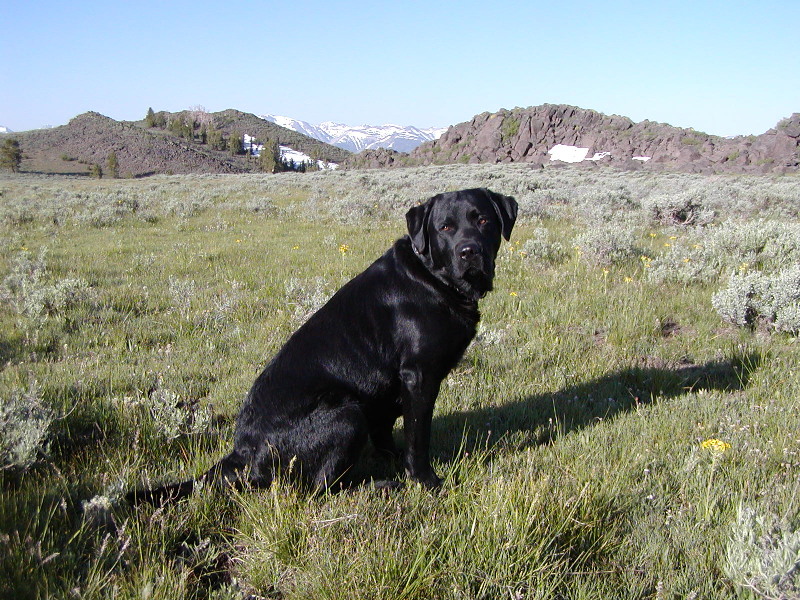
See Tide's page here. Tide at 2 years old (Sired by Bart).
TRIP REPORT.... Tuesday (7/5/5) I headed off for
a few days in the Sweetwater
Mountains near the border between California and Nevada. I took Tide on
this trip, instead of Bart, to get him used to coyote hunting and
fetching trout. By noon we arrived at a small creek near Red Lake and
caught 4 brooks and one rainbow. Tide kept trying to get ahead of me
and that would have spooked the fish so I put him on the short leash
tied to my belt. Tide didn’t want to fetch the fish even when I lifted
them out on the bank and would jump back when they flopped in the
grass. Bart will fetch them out of the water when I bring them up to
the surface. Tide needs more training.
ALL THE WAY.... We continued on up to the Sweetwater's and I
stopped in the Star Camp Site (beautiful campsite in the white bark
pines), but the biting flies and mosquitoes were very bad. While
fighting the flies, I got out the 17 HMR and shot 3 starlings for Tide
to fetch. The place where the birds were was a bog and Tide turned into
a mud dog fetching the birds. He was a little slow on the first one,
and dropped it a couple of times on the way end, but finally delivered
it to hand. No fancy finish at heel by that time. The 17 HMR really
messes up a starling sized bird.
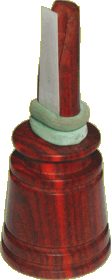
Long Valley Predator Call
CALLING A COYOTE.... Moved to a big sandy flat
to make my Stop-n-Drop camp to get away from the bugs. When we got
there (about 9000’ and not a tree for a mile), I had Tide do about 10
long bumper fetches to tire him out a bit. Just about sunset we went
coyote calling over the horizon about 400 yards away from camp. I sat
Tide beside me on the doubled up short leash and got out the Long
Valley
Predator Call. I gave out a series of hurt jackrabbit. After about the
third series Tide started barking and a coyote had stopped on my left
at about 75 yards. Tide was tugging at the leash and the coyote was
just standing there. By the time I could get the rifle into position,
the coyote had started running around to get down wind. Tide was
whining and barking trying to get free. Tide sure was excited. Well,
the coyote stopped at about 150 yards and I missed. No excuses, I just
plain missed! A brown jet was flying down the hill through the
sagebrush and there was no way I could have hit it running that fast
with Tide pulling on me. It was exciting for both Tide and me.
TIME TO RELAX (NOT).... We went back to camp in the sand and I
popped the tab on a cold can of beer and was just taking it easy. The
sleeping bag and bed was all out and I was just relaxing. Well, Tide
saw 4 wild horses at about 400 yards and took off like a bullet toward
them barking and growling. He left a dust contrail and I could hardly
see him through the dust cloud. I whistled at him and was able to call
him back after he had covered about half the distance to the wild
horses. He came back slowly and the horses just stopped, but did not
run off. When Tide got back, I put him on my belt leash. Then the
stallion started toward us and the 3 other horses followed a bit
behind. We just sat there and at about 100 yards, the stallion started
zigzagging and whining and coming toward us. I don’t know about horses,
but that sucker was threatening us and trying to run us out of his
territory. I reached down and got my Ruger 101 357 Mag that I keep at
bedside and took it out of the holster and the stallion is still
getting closer. Tide is barking and growling at him and I was thinking
“one in the air and then 4 in the hair” if he comes all the way in. The
stallion finally stopped at about 50 yards and just stood there. We
looked at each other for about a minute and finally he turned around
and calmly walked away. We watched the 4 wild horses walk to the far
hillside at about 1000 yards and finally it got too dark to see them.
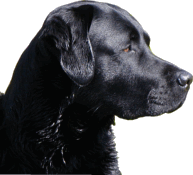
OWL ATTACK.... Well, I open the second calming
can of beer and here comes an owl and it swoops down at Tide. Tide
didn’t know what to do. The owl would fly around and then come back and
swoop down at Tide. This went on for about 5 minutes. Tide would run
around and the owl would come back for another swoop. Finally the owl
lit on a sagebrush and Tide was after him like a shot. Up went the owl
and he made a few more swoops and left. That was enough excitement for
Tide in one day.
BACK TO STAR CAMP.... Wednesday, up early and made 3 stands, but
no coyotes.
I did see a nice buck 2x2 in velvet at about 400 yards while eating my
breakfast
cereal. Tide was doing well until it started getting hot. I took him
over to the little creek and he jumped right in and cooled down. Then
we went back to the Star Camp. I shot him a couple more starlings with
the 17 HMR. On the second one he didn’t want to fetch it. It was about
80 yards out in the bog and he would pick it up and then drop it. I
finally got him to bring it in and it turned out that it was a single
wing. The bird must have been messed up pretty bad from the 17 HMR. We
went up the road a little ways and I saw a Beldings ground squirrel. We
sat for a few and finally the ground squirrel climbed up on a dead
branch on the ground. The 17 HMR barked and I sent Tide out with hand
signals. With a rifle, Tide can't tell where I am shooting. He is used
to birds falling out of the air and the 17 HMR is new to him. Anyhow, I
directed him to the ground squirrel and he fetched it. He didn’t like
it very much because it was really a mess.
GOING HIGHER.... We decided to go high and went up to a tall
mountain with many radio antennas on top. The elevation must be about
11000’. At that elevation, my portable packet radio station using my
truck’s 2m ham radio could reach my Network Node TRACY and my mountain
cabin. I sent Mary Ann a packet message. I was quite proud that my
TRACY node could be hit from there, about 200 miles. We dropped down
about 500’ to a flat area and got the Stop-n-Drop camp setup. We did a
couple of coyote stands around sunset, but no takers.
WAKEUP CALL.... Thursday morning, I was awakened by a coyote
barking at me. The coyote was about 60 yards out and giving the warning
barks. Tide was in the truck and I was afraid he was going to run off
after it. But I called him to me and he came to heel. The coyote kept
barking while I was putting on my pants and shoes. I leashed up Tide
and got my
old Sako rifle in 243 Win caliber and shooting sticks from behind the
truck seat. The coyote stopped barking while I was jacking a round into
the chamber. I just turned around and Tide sat beside me. I put the
rifle on the Bi-Fur-Pod. There was the coyote silhouetted on the
horizon at the red dot. It was about 100 yards. I would never take a
shot like that in a populated area, but I took this one. I aimed right
behind the shoulder. Bang! The coyote went down and out of sight.
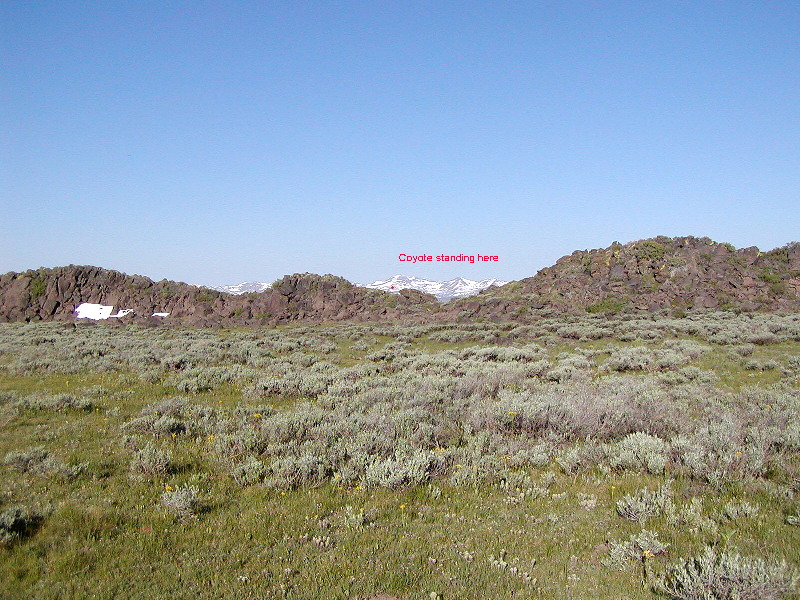
Here is the shot: The coyote standing at the red dot.
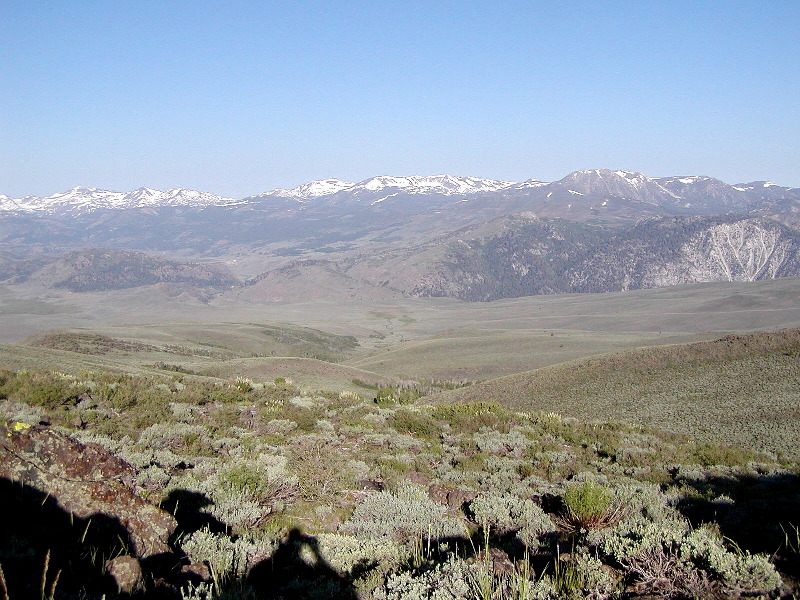
Before anyone gets excited and wants to lecture me on taking such a
shot when one is not sure of the backstop, here is a picture of what is
on the other side of the coyote:
Down Range for 50 miles.
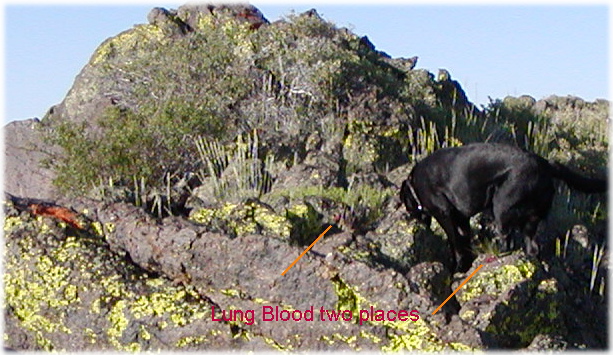
COULDN'T FIND THE COYOTE.... At the shot, the coyote had
dropped. I took Tide over to see the coyote, but no coyote. There were
two large lung blood spots on the
rocks. Tide was sniffing and he started down the back side of the hill.
We went quite a ways, but couldn’t find the coyote. They can go a long
ways with a lung shot. Gave up and went back to the truck for breakfast
and packing up camp. I had to dry the sleeping bag from all the dew
during the night.
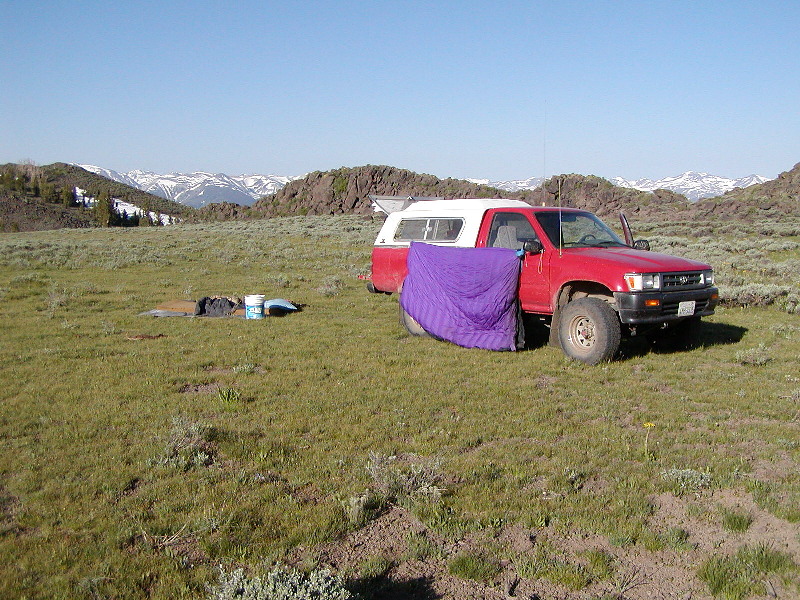
BEAUTY IS IN THE EYE OF THE BEHOLDER.... Here is the beautiful campsite: Drying dew off the sleeping bag. Not too much shade here.
FOUND IT.... After breakfast, we were going to find that coyote.
With that much blood, it couldn’t have gone very far. We went over the
hill where the coyote had gone. I found one blood spot down about 10’
and we went a little farther. Then I got smart. I told Tide: “Dead
Bird”. That is what I say when a pheasant is down. Tide got serious
then and started sniffing around in earnest. We went down about 50
yards and Tide was on the trail. I saw the coyote and it was face down
between two rocks. Tide didn’t see it and walked all around it. Then he
saw it! He did something I have never seen him do. He grabbed the
coyote by the back of the neck and shook it viciously. I didn’t know
that was in him. He must have had a run in with a coyote on Bethel
Island where we have a pack of them. Tide does not like coyotes!!
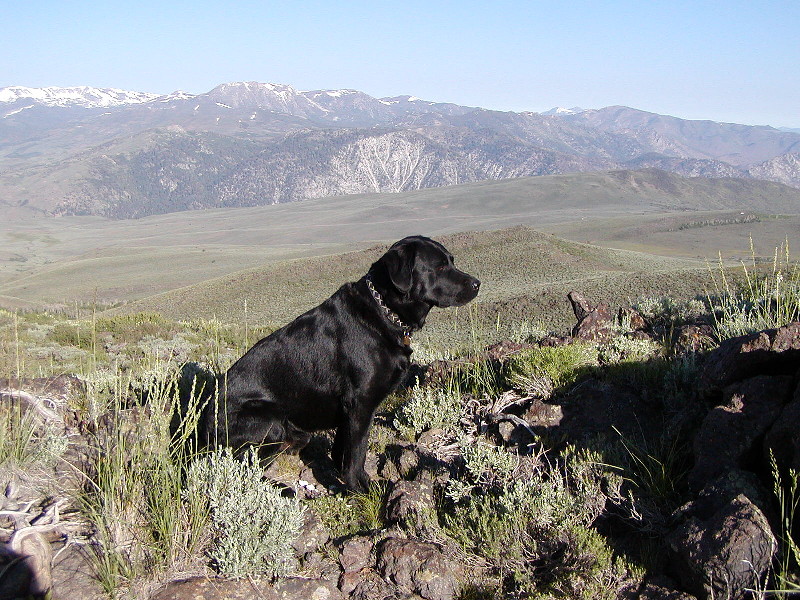
TIDE ENJOYED THE TRIP.... We made a couple more stands, but it
got very hot and we finally headed home. I stopped at two places to
fetch Tide in the water so he could stay cool. Tide being comfortable
is more important than keeping the old rug kit in my truck dry.
It was an interesting trip and exciting for Tide. There will not be any
trouble talking him into another trip to the
Sweetwater's.
Bill's Cross Fox
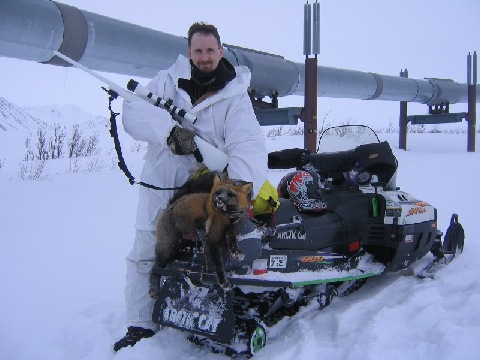
Al, I love your web site! It's the most helpful and
informative site on varmint hunting that I've seen. I have downloaded
many of your sound files and look forward to trying them out this
winter. I am sending you a picture of a fox I took to years ago here in
Alaska. This is what we call a cross fox. Since both red fox and silver
fox occur in the wild here, crosses are quite common.
The time of year was late March-early April; mating time for fox and
coyotes here. My brother and I were cruising the bluffs of the Delta
river looking for critters in the river bottom. My brother spotted two
foxes over a mile away and we set of on the edge of the bluff. By the
time we got settled only one fox was visible. I started blowing my
mouth call and the cross took off on a beeline up the river bottom
towards us. Each time she stopped running I would give the wounded
rabbit call another toot. The second the sound got to her she would
take off again. The other fox popped out and joined the chase but she
was already half way to us. She dropped out of our view as she neared
the bluffs we were on, but she immerged directly below us when she
rounded the point of the bluff. We estimate my shot at 80-100 yards.
This was the first time I used my CZ 527 .17/.223 and the 25 grain
Hornady found its mark. The male red fox never did show himself. As you
can see by the picture, we were hunting along the Alaska Pipeline.
Right of way permits are issued by the pipeline security folks once
hunters provide basic information and positive ID. Security helicopters
patrol the length of the pipeline and routinely land to check that
right of way permits are in hand.
I took 4 foxes and one coyote last winter, but those were taken after
being spotted from the road and stalked. The toughest one by far was
the coyote. I spotted him crossing a creek bed about 120 yards off the
road. I parked the truck and grabbed my .17/.223 and stepped onto the
packed snow burm on the side of the road and laid prone for the shot. I
hit him on the first shot but it hit a little far back so I fired again
and missed as he went into the brush. I watched him stumble so I
figured he wouldn't go far. I returned to the truck to put on my boots
for the hike to recover the coyote. I returned to the shooting point
and saw the coyote laying still on the edge of the brush. I started off
the snow
burm toward the dog when I stepped into the fresh snow; UP TO MY CROTCH
! It was then I realized I had left my snow shoes at home 300 miles
away. I post holed the 150 yards to the dog's final resting place and
it only took me 30 minutes to get there. Ugh. On the trip back to the
truck the coyote I was dragging kept falling in the deep holes of my
footprints. It took at least 45 minutes to get back to the truck and I
was completely soaked from snow and sweat. I will remember my first fox
and coyote for a long time. I will also remember my snowshoes EVERY
TIME. Bill
DEER HUNTING STORIES
1997 Mule
Deer Hunt or Who got the Lion's Share?

HI-TECH HUNT.... Six of us were drawn for the Northeastern California X3B-Zone 1997 deer hunt. It was a very interesting and fun time. The early party of three drove up on Thursday and arrived in time to setup camp. We scouted the hunt area Friday, the day before the season. I mounted my Garmin GPS 45XL unit in the truck and was going to drive all the roads in the area so we could download the tracklog data on all of our GPS units, using the laptop. Yes, this was a Hi-Tech hunt, with computer, ham radios, and GPS units. That way we could stay away from the roads when we wanted to and get to a road when we needed to. I have the Garmin software that allows you to store the data on the laptop and download to other units. On the first road, about half a mile from camp, I spotted six deer. There were five bucks, a 3x3 and four forked horns and one happy doe that was getting some attention. They were not spooked at all. I watched them and called my buddies on the ham radio and told them what I saw. The deer moved over to a tiny bunch of quaking aspens and started attacking them with their horns while one buck was accommodating the doe. It was a regular rub area. Well, the other guys arrived and the deer were still there. We didn't have good enough camera gear to get any pictures that showed more than specks for the deer. Finally, after about 30 minutes total, they all walked away. Our spirits were high!
OPENING DAY.... Saturday, the early group went out and didn’t see any bucks in the morning. About 4:00PM, when the three in the late group arrived, I was out hunting and spotted a buck and passed him up. He did not look healthy and his antlers were deformed. He had a tiny fork on the right side and medium fork on the left side that still had some dried velvet on it. He sure was stupid. He stood and looked at me for quite a while. It would have been an easy 75 yard shot. (The next day a "road hunter" got this buck with the deformed antlers). About an hour later, David in the late group went out hunting and was only out for about 5 minutes, when Rich, his dad, jumped 2 deer and they headed straight to David. A large forked horn with very heavy tines and a 20+ inch spread stopped at 50 yards from David. He made a great neck shot with his 243 and his hunting season was over. Here is David and his deer.


DAY TWO.... Sunday, Rich was hunting in the "Deer Candy" on a north facing slope. The common name for this bush is Pacific ninebark and the scientific name from the Rosaceae family is Physocarpus capitatus. I put a leaf in the scanner and here is what it looks like. The deer like to stay near the areas where these bushes grow and that is why we gave it the "Deer Candy" name. Rich jumped this nice 3x3 and took a kneeling shot with his 270, when it stopped at about 140 yards. He hit it right through the boiler room, without rupturing the diaphragm, and had his Mule Deer.

MY DEER.... Later the same day, I was hunting in the Deer Candy and walking uphill very quietly. I glimpsed the back of a deer between the trees at what was 140 yards. I moved slightly so I could see its head and it was a forked horn. I decided to take it, since David and Rich had filled their tags and this was probably going to be my last chance. I unfolded my Bi-Fur-Pod to a unipod and had a problem. The tension on the pivot screw was low and it was difficult to make it stay straight. Well I finally got it setup and moved so I could see the deer’s shoulder between the trees. I had about a 1 foot "window" to shoot through. I touched one off with my Sako 243 and had a good sight picture when it went off. I saw the deer go out of sight to the right.
CAN'T FIND THE BUCK.... I marked the place where I shot from and made a beeline to the spot between the trees. When I got to where I thought the deer was standing, there were lots of tracks. But I couldn’t find any tracks where a deer was running hard. I looked for a blood trail and there was none. I went back and checked the trees on each side of the "sight window" and there were a number of holes that could have been bullet holes, but I couldn't get the nail on the end of my Bi-Fur-Pod to go into any of the holes. (Use #6 for the Bi-Fur-Pod). It was getting dark and I started making circles down hill looking for the deer. Nothing. I went back to where I shot from and again, traced my path. It ended up at the same spot. Well, I made a mark and put a stick on a rock so I could find the place again. In the excitement, I forgot to get a GPS reading. When I got back to the truck, I shot a pine tree and noticed it was easy to push the nail on the Bi-Fur-Pod into the bullet hole, so I was sure I didn't hit a tree.
LOOK HARDER.... The next morning I went back to the spot to take another look. The weather was very cool and the deer would not spoil overnight. I got back to the place where I had fired the shot and got a track through the "window" between the trees again. I also notice that there was a stump farther up the "window" so I could look farther down the track. When I got over to the tracks I saw, I looked carefully and found nothing. Then, I went past the stump and sighted back through the "window" to where I had shot from. I went up on a little promontory and there was big dig in the dirt where the buck had launched from. I saw one set of tracks where he hit the ground about 10 feet down the hill and a big blood blotch on a log. I had just not gone far enough down the line of sight the night before. I followed the blood trail about 40 feet and saw where the buck had gone down.
WHOSE DEER IS IT? But there were drag marks. Somebody was dragging my deer! The drag marks led about 50 feet into a clump of small trees and there was the deer covered up with dirt and twigs. It was a nice forked horn, but a mountain lion had found it in the night and claimed it as his own food. I marked the location with the GPS unit and, while I was doing it, I heard something in the brush up the hill.
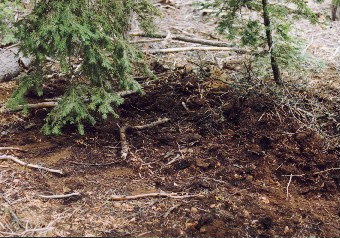 The
covered deer.
The
covered deer. 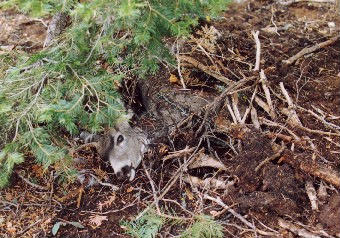 The head.
The head.
I decided that this was a good time to get some backup while I reclaim at least the hams and head of my deer. I also wanted some wittiness to verify what had happened. About 2 hours later we assembled all six hunters and went to recover my deer. We found it easily with the GPS fix. The mountain lion had not returned and we took pictures of the buried deer and the lion tracks. Here I am about ready to pull the buck out of the dirt pile.
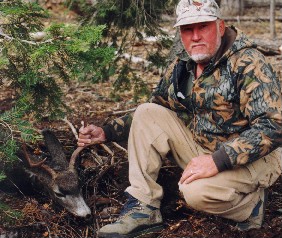
When we pulled the deer out from under the debris, it was a pretty smelly mess. The lion had completely eaten the left front shoulder and about half of the left ham. The bullet had entered just in front of the right shoulder and exited somewhere centered on the left shoulder. The hit was about 10 inches forward of where I had called the shot. One is allowed a little error with all of the adrenaline and the heat of the excitement. There was no 10 inch wind blowing, so I couldn't blame it on wind.
THE LION'S SHARE.... About all I could salvage was the right ham. I took the head and the right ham and left the "lion's share" to the lion, but uncovered. The lion was probably not too happy when it got back and found that someone had disturbed his food store. Besides, every one in the party applied a scent mark to the area before we left. It could have been just a nervous pee. When the forestry worker validated the deer tags, he was quite interested in the lion evidence. He claimed that he did not carry protection when he was out marking trees, but did it with a nervous laugh. The story will give him something to think about while he is working.
All in all, it was a good hunt. We got 2.2 bucks for six
hunters and had a great time.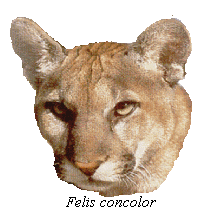
Note: Here in California, the liberals have been able to pass legislation that outlaws all mountain lion hunting and they are rapidly increasing in numbers. We are seeing serious reductions in the deer herds and have lost a number of people and at least one lady jogger, wearing Nikes, to mountain lions. Click HERE for more on Mountain Lion Habits.
In 1924, nearly a dozen such ancient decoys were discovered by
archeologists in a cave in Nevada, close to the now dry Lake Lahontan.
These decoys were deftly made from tule reed that had been cut, bent,
and tied to create realistic looking decoys that resembled the
canvasback duck. In addition to the decoys, the archaeologists also
found nets and fishhooks.
After they first settlers come to America, they realized how much
easier hunting became through the use of decoys after seeing them used
by Native Americans. These settlers began creating their own unique
decoys using carved woods and paint.
The population began to increase as more colonists arrive in America,
creating a higher demand for food. To meet this demand, a group of
“market gunners” started hunting waterfowl on a larger scale, which
then created the need for more waterfowl decoys. These commercial hunters created new decoys that had a more realistic look and floated better.
In later years, companies such as Peterson-Dodge and Mason Factory took
advantage of this increased demand for decoys. They created businesses
in the 19th century that used assembly lines to create decoys made from
cedar wood.
Interestingly, while decoys remain a very popular hunting aid, they
have also entered the arts marketplace. Decoys have become highly
collectible pieces of folk art with collectors willing to pay a pretty
penny for them. In fact, one decoy actually sold for an astonish $1.13
million. With a price tag like that, it is probably unlikely that that
decoy will be seen floating in a pond!
Justin Sieverding
has spent most of his life hunting waterfowl in South Dakota and
throughout North America. Justin has a true passion and vast experience
in everything related to waterfowl hunting including decoy spreads,
bird patterns, scouting, and calling.
THE HARD LUCK BUCK.... I went on a solo deer hunting trip up at my mountain cabin in the 1987 A-Zone season. I had hunted the early morning and had not seen any deer, so I packed it in until the afternoon hunt. It is hot that time of the year in California's Coastal Range. About 6:00PM I tanked up on water because I don't carry a water bottle, and headed up the mountain north of the cabin. At about 300 yards from the top and huffing and puffing pretty well, I sat in the shade of an oak tree for a long rest and to just watch what was going on. The south sides of the mountains are mostly bare with most of the trees and brush on the north facing slopes.
After about 20 minutes, a coyote came over the top of the mountain and sat down and looked at me. I setup my Bi-Fur-Pod and dialed in 300 yards on the Tasco 3-9X Rangefinder scope and nailed the coyote. We had lost a lot of deer the previous winter to coyote predation and I figured I had just saved about 20 deer during the next winter. I also assumed that I had ruined all chances for seeing any deer, so I got up and started climbing up to the coyote. It was not a direct route, because there was a ravine in the way and it took me 30 minutes to get to the coyote.
When I got up to the top, I sat down for a rest, looking down on mostly a clear hillside. I saw some movement at a lone juniper in another ravine at about 300 yards and it turned out to be two forked horn bucks. Again, I dialed in 300 yards and setup the Bi-Fur-Pod and centered on the withers of the trailing buck. I dropped him with single shot. I promptly forgot the coyote and started down the hill to get the buck to the cabin before dark. The sun had already set. I knew it was going to be a long haul down the hill, so on the way down, I left my gun and Bi-Fur-Pod it an easy place to be picked up the next morning (Bad move).
I got to where the buck went down and he wasn't there! He had gone under the lone juniper tree and was standing looking at me. The buck's left shoulder was destroyed, but he could move faster on 3 legs than I could on 2. Well, all I had was my knife and my fanny pack and when I moved, I spooked him and he started running down the hill, lost his balance and tumbled downhill about 40 yards, head over heals. I started running back toward where I had left my rifle and when I got back, it was getting pretty dark, but I spotted him laying down with his head up. I made a neck shot to finish him off. He was on some very steep terrain now. I finally got over to him with a lot of slipping and sliding and was shocked! BOTH of his antlers had broken off when he tumbled down the hill.
Here I was. It was almost black dark, on a steep hill and I am in possession of an illegal buck! In the A-Zone, a legal deer has to have at least one fork. It was too dark to look for the broken-off forks. I field dressed the deer in the dark and started dragging him down the ravine to the road below, about a mile away. There was a lot of poison oak on the way, but what you can't see, can't hurt you, right?
I got the buck to the road and walked back to the cabin and got my truck. By about 11:00PM, I was skinning the buck and completed things by about 2:00pm. At daylight the next morning, I went up the north mountain again to find the rest of the buck's horns so I would have a legal buck. I got up there and looked for an hour or so on the very steep hillside and finally found the one fork. Assured that I now had a legal buck, I headed back to the cabin. When I tried to piece the horns together, there was a MISSING piece between the stumps and the fork! Back to the north mountain. I hunted another hour and finally found the missing piece. I was lucky, because it was the correct missing piece. It could have been the one from the other side.
The way the horns were fractured indicated it was primarily a compressive load. During high compression, the mode of failure is usually in shear. As one shear plane begins to fail it puts even a higher load on the mirror shear plane and as the column buckles a second failure location also occurs, hence the separate piece is generated. If the horn had been loaded in pure bending, there would not have been a separate piece generated. A bit of engineering analysis here on failure theory.
When I took the buck to the police station to get it validated by an official, I told the policeman that the horn broke and I had all the pieces. He didn't even want to see the horn pieces. I told him to wait a minute! I had spent half a day recovering the pieces, he was going to take a few minutes to see that it was really a legal buck. He watched while I carefully showed him how the pieces fit together.
The moral of the story: 1. Don't go hunting solo, you might get a deer. 2. Don't lay your gun down when you go to retrieve your buck. 3. Make sure when you buck falls, it puts a pure bending load on the horn so in case it breaks off, you won't have to look for the missing pieces.
Footnote: I found the other fork 2 years later in the stream bed after a hard rain, but it didn't fit, because there was also a missing piece on that side. I no longer use the .243 100 gr. Sierra ProHunter bullets. I have switched to the 243 100 gr. Nosler Partition bullets. They are very expensive, but do not blowup on the surface and provide deep penetration with good expansion.
BULL FEVER & THE A-ZONE 1997 DEER HUNT.... Four of us went up to my mountain cabin deer hunting on opening day of the 1997 A-Zone deer season here in California. I did not see any buck deer, but did have a memorable experience. It was an exciting opening morning. I went out hunting on the north ridge before daylight. As I was climbing up the hillside, I saw a BIG Black Angus bull (some ranchers let their cattle roam free). He was near a break in my fence line and inside my property. I normally don't pay bulls any particular attention, but when this bull saw me got to his feet and turned facing me, with his head down, at about 75 feet. I moved so that the fence line was between us (good move) and continued walking up the hill. When I got about 50 feet from him, he charged me. He was running very fast directly at me and stopped about 10 feet from me. He was still on the other side of the fence which is old and rickety barbed wire fence and has many holes in it. His head was down and he was snorting at me. I am sure that there was blue smoke coming out of both nostrils and lots of white showing in both eyes. I am not much of a matador and didn't know the correct veronica for the occasion, so I fired a shot about 2 feet over his head from the 243 Win. It was still dark in the early morning and the muzzle flash extended halfway to the bull. He rolled his eyes, turned and started walking slowly off to the east away from me. If you think buck fever makes you shaky, try bull fever! It's worse. Well the shot spooked all the deer that would have been in the area. I didn't see a single deer after that and the bull stayed at the north end of my property all day. His ears were probably still ringing. I wrote Mary Ann a packet message from the cabin ham radio station and she quipped back: "Hola Don Jose Alfredo el matador grande!! Guess we won't have any beef burgers. That's o.k. They'd be tough, anyway." At least Mary Ann could laugh about it.
A-ZONE 1996 DEER HUNT.... Four of us went up to my mountain cabin about 20 miles south of Livermore at 2700 ft
. There was myself, Dick, Lee, and another Lee. We went up Friday August 9, the day before opening day. It was extremely hot, at least 105 F in the shade, and no wind. An ice chest full cold Henry Weinhard's helped us through the hot afternoon and evening.Opening day we were out at first light and I was heading up the north hill. Just as I topped the ridge in front of the "flat-topped" pine tree, I saw a deer and stopped. It was a 2x2, still in the velvet, eating grass and he didn't see me. I took a couple of deep breaths and set down and put my rifle on my Bi-Fur-Pod shooting sticks. When he turned sideways, the A Zone hunting season was over for me at 6:20 AM on opening day. The hunt had lasted less than 30 minutes.
After the shot a second buck, much bigger than mine, possibly a 3x3, ran up into view about 20 feet and looked at the fallen deer and then looked at me. This buck stood there for a minute or so and then just started eating grass. I called Lee on the radio (we are all ham radio operators) and told him there was a second bigger buck, but he was too far away to get there in time. After about 10 minutes, the big buck must have heard or smelled me and just walked over the hill. We never saw him again.
The hunting phase was over, now the hard work began of getting the little buck back to camp. We skinned the deer out and had him in the Livermore meat locker and were back at the cabin by noon. That is the shortest deer season I have ever experienced. Of course we are still right in the middle of wild pig season. It lasts all year long and the limit is one a day. We are getting ready for the C Zone hunt that starts on September 21. Some days are diamonds and some days are stones. Opening day was definitely a big diamond for me. No one else saw any bucks. I guess I was just in the right place at the right time. That is the way it goes sometimes.
ZONE-X3B 1995 MULE DEER HUNT.... We went up to Don's Pepperdine camp near the Warner Wilderness. Don has a small ranch just outside of Alturas and drives his cattle truck to supplement what he makes from the cattle and hay. We were at 6800 ft about 3 miles north of Squaw Peak. We stayed in one of the cabins and even had a wood stove and running water. We hunted the wilderness Saturday and Sunday morning and didn't see any sign of buck deer. There were a few doe tracks, but none of the big buck tracks. We then went to an area about 8 miles north of Don's cabin. Rich, one of the guys in our party, found big buck tracks in the road and Sunday evening, found a bachelor heard of about 5 bucks. Two forked horned bucks were fighting at about 120 yards. He took one of the forked horn bucks with one shot through the lungs just behind the shoulder. The next morning, he took his boy back to the same area and they couldn't find the bachelor heard again.
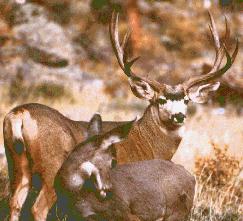
Odocoileus hemionus
Tuesday, all four of us went to the same area and I found the bachelor heard. They didn't see or hear me. I straightened out my Bi-Fur-Pod for a rifle rest. I only moved when the bucks had their heads down eating. I was ready to take a 3 by 3 standing at 100 yards, and he turned directly away and I had to wait. Then I saw a second 2 by 4 buck with larger horns and took it. It must have weighed more than 200 lb. on the hoof, one shot, walking quartering away through the lungs behind the shoulder and exiting in front of the off shoulder. That split up the bachelor heard. That evening, David (Rich's boy) jumped a nice forked horn and made a beautiful running shot at 80 yards. The buck was running directly away from him, up hill and he broke its neck just under its chin. Todd got a one second look at a legal buck but didn't get a shot. A 75% average was pretty good, 2 forked horns and a 2 by 4 with 3 shots for a party of four hunters can be considered a successful hunt.
Hi Al,
Just thought you might like to hear how it’s done this side of the pond.
First I have to tell you that our deer hunting seasons are really
long in England and Wales and run from April to October for roe buck,
from August to April for fallow buck, red stag and sika stag with no
close season at all for muntjac (chinese water deer are very localized
so generally are not hunted very much). The female deer season is
basically November to March. In Scotland the red and sika stag season
is different, from July to October but the rest is basically similar.
I started deer hunting in 1977 in the south-west of England, an area
always known as Wessex, the old Anglo-Saxon word. I hunted under the
watchful guidance of a professional hunter and, as I didn’t have the
expendable income to shoot trophy bucks (very expensive!!!) I hunted
only control animals, the overall deer herd being very carefully
controlled for health, gender balance and trophy quality. The area
under the control of the professional was about 25,000 acres of private
forest plus the surrounding farm lands. We mostly hunted roe deer but
there were also a small population of fallow. To maintain a steady
population level the total cull for a year was about 200 bucks and 250
does. The wealthy ‘clients’ only shot the really good trophies which
made up no more than half the buck harvest so it left plenty of control
animals to hunt the year round. It was a good way to learn about deer
as I had to be able to judge the age, condition and quality of bucks on
the hoof to decide if they were to be taken or left. Mistakes were not
allowed, if I wasn’t sure I didn’t shoot. But as roe are very
territorial we could usually find the same buck another day and let the
professional make the decision. I looked at an awful lot of deer in
those early days until I was confident and knowledgeable enough about
them to be able to act as a part time guide for the wealthy clients. I
guided a lot of guys till about the early 90’s when I moved to Ireland.
I guided European royalty, multi-millionaires, politicians and all
sorts and it always struck me that you could never tell what sort of
sportsman the client was until he had the deer in his scope. Personal
background didn’t seem to be a factor but quite often, regardless of
how rich they were, at the end of the hunt if they didn’t think they
had the best trophy possible they would bitch about the costs even
though they had some great hunts and some lovely trophies. I thoroughly
enjoyed myself all through this era and even managed to get myself a
couple of good trophies in the process.
At the same time as this I was also spending quite some time in
Scotland shooting some roe deer but mostly foxes. There must be
millions of foxes in Scotland. There are generally large numbers of
rabbits, hares and feathered game and the fox numbers are abundant in
relation. I had a friend who was a gamekeeper and he was well known in
the area for his fox population reducing exploits so we had plenty of
land to shoot over. As the foxes there are totally nocturnal all our
shooting was done with a powerful lamp at night. The rifle I was using
at the time was a Tikka LSA55 in .243. I loaded the 105 grain Speer
spitzer for deer and had it printing 1” high at 100 yards and the 60
grain Sierra hollow point that printed just over ½” higher but dead on
centre with the same point of aim, the groups from either round cutting
a clover leaf all day and I could shoot out to 300 yards with that 60
grain bullet without having to worry about holdover. I have to admit
though that the loads I was using were very hot according to the book
but that rifle seemed to take them in its stride. My record for one
night was 8 foxes, I often had 4 or 5 in a night and had several
‘doubles’ when 2 foxes come to the call together and I got them both.
Eventually, after about 10 years and hundreds of foxes and deer the
barrel wore out. I shot at a sitting fox one night at about 70 yards
with the 60 grain load. The rifle fired OK with the usual recoil but
nothing happened to the fox, he just sat there and scratched his ear.
My friend went into convulsions of laughter saying I’d missed a sitter
on the end of the barrel, etc. etc. but when I went to the range the
bullets weren’t hitting the target, they were exploding on exiting the
barrel. It would still shoot the 105’s but the 60’s were
disintegrating. I cleaned the barrel and, with a light, I looked up the
bore to see that for about 6” in from the chamber the rifling had
vanished with another 3” of very rough stuff. The 60 grain bullet
jackets must have been getting damaged in this area and breaking up.
I switched then to a .222 Remington for the varmints (you can also
shoot roe in Scotland with a .222 but not in England or Wales) and a
30-06 for the deer. I used a .308 for deer for a while but found the
recoil very sharp, I found the 30-06 to be much more comfortable to
shoot. One day I had a call from my Scottish pal he said that a couple
of hill stalkers (professional deer hunters) owed him some favours so
he had booked me onto 2 hill stalks, one for a red stag and the other
for roe bucks. Now although I had been born and bread on the side of a
mountain I had always hunted deer on low ground. The Scottish mountains
are steep and very high and the stalkers, who are born and reared in
these areas, are well known for making the clients work hard.
Determined not to look daft I went into training, lost some weight and
used stairs instead of lifts at every opportunity, etc. as I knew that
the red stag hunt would be arduous at best. A red stag hunt is
generally conducted during the day as it is on open hill ground. A stag
is spotted at some distance and ‘stalked’ to get within reasonable
shooting distance, usually less than 150 yards. We arrived at about 10
o’clock on a lovely fine August day and, with the stalker set off in
his ATV into the mountains. We came to the place where the base of 2
mountains came together with a burn or stream flowing down each one and
joining into a larger stream. The stalker got out his large spotting
scope, looked up at the mountain and said ‘That herd will do. About 500
animals, mostly hinds (females) and calves but some stags.’
Well, looking up the hill (about 30 degree elevation!!!) through my
Zeiss 8 power binoculars I couldn’t see one deer. I asked him where
they were. He described that they were below the peat hag and just to
the left of the large white rock. I got the peat hag and the rock but
still no deer, let alone 500 of them. He turns to me and seeing my
binoculars asks what the magnification is. I says 8 power whereupon he
says ‘you won’t be able to see the deer with them wee things laddie,
just look for lots of wee red pin pricks’. As he said it the hillside
became plastered with wee red pin pricks!
‘And how far away would they be?’ I asked in a slight state of panic.
‘Och, no more than 2 hours fast walking’ he
replied. So off we set. Let me tell you that a fast walk up a 30 degree
slope is no joke, and the 2 hours had been optimistic. Thank goodness
I’d been in training. We slogged away but just when we were getting to
the herd some sheep that we hadn’t seen panicked and frightened the
deer over onto the adjacent hill. Oh well I thought it’s a pity I won’t
get a stag but the view was nice at the top of the mountain. Just then
the stalker says ‘drat, they’ve gone over on tae the other hill. We’ll
have to go all the way back down and up that ain’. I laughed thinking
he was joking – he wasn’t. Down we went and up we went again. I had to
crawl on my belly over the heather for the last 30 minutes and finally
got my stag at 5 o’clock that evening.
I thanked the stalker for the outing to which he replied with feeling
‘och, I’m sorry it was no much of a go. Come back when we’re culling
the hinds, it’s much more challenging and the weathers no so dashed
warm’. I didn’t take him up on the hind stalking, I don’t think I would
have survived it!
Let the folks know that I’ve lived in Ireland for over 15 years
now and all my old contacts in UK have sadly passed over to the Great
Hunting Grounds but I will certainly answer any general questions. When
I get the opportunity I’ll write some more about different aspects over
here.
Best regards,
Tim
Klaus' Roe Deer Hunt in
Denmark
May 2000
Note: Dick Hatfield and I have been communicating with Klaus via email for quite some time about rifles and reloading for accuracy. He gave me permission to reproduce his Roe Deer Hunt story here. Klaus has done a very good job writing this in English and I did not do any editing that could possibly diminish the meaning or excitement of his success story. When Klaus sends the photos, they will be included in the story.
Hej alle!
Bukkejagten starter i morgen tidlig kl. 05.07,- jeg er på plads kl. 04.00.
Har i den sidste tid set 2-3 råer på mit terræn, men ingen buk. Der er dog 4 gode fejninger i skoven.
Var her til aften igen oppe på jagtterænnet for at kikke efter råbuk. Jeg så ingen buk, men en rå som gik
og græssede på den lave eng. Nå "pyt" bukken kommer vel i morgen tidlig,- "håber jeg".
Hi everybody!
Open season for roedeer starts tomorrow morning 05.07,- I will be there 04.00.
In the last week I have seen three to four does at my hunting ground,- but no buck. In the forrest there
are four places where bucks have scrubbing there antlers on small trees. This evening I have been loking for
buck too, but I saw none. A single doe was forageing in the bottom of a valley. Tomorrow morning he will
be there,- "I hope".
First of all, this mail is in english, and is mainly addressed to Dick Hatfield and Varmint All in California. Actually I just want to say "hello" to my family and Danish freinds with this mail, to tell them that I took a roedeer buck on the first day. So "hello" to your all,- and please forget the details,- but of course you are welcome to read them if you want to. Doing it this way, I do not need to write the story two times, English and Danish.
Time was about 20.00 when I left my home, to drowe the 4 kilometers up to my hunting area. There was a familiar smell of mosquito repellant in the car,- not quit pleasant actually, but in Denmark at this time of the year, you have to be well rubbed in mosquito repellant, unless you can accept to be "attacked" every second. My Sauer 200 TR cal. 6 mm. Remington BR laid on the back seat, and I had 3 cartridges in my pocket, with the 70 gr. Sierra Match King bullet. Powder was 36 gr. N150. muzzle velocity 1060 m/sec. I was not quit happy to use a match projectile to hunt, but I really have tryed very hard to find a hunting projectile that could shoot accurately in the barrel. Not even the 70 gr. Ballistic Tip could do it. So Dick Hatfield and my Danish gunsmith proposed me to use the 70 gr. Sierra Match King bullet, which goes wery accurately in the barrel, (under 10 mm. groups at 100 m.) so thats why my rounds are loaded up with 70 gr. Sierra Match King bullet, and why they are in my pocket right now. So in the meantime when we are driving, I can tell you that I have been doing a lot op training up to this roedeer season, both short range (under 150 m.) and long range (up to 325 m.) Why?,- because a lot of times I have gone home without the buck, because the range was too long,- and I do NOT want to wound the deer,- so I hold my fire. Therefore this year I have put a roedeer silhuette on a field, in a hedge, and so on, and fired my rounds from varios distancees. But before I did that, I had made a ballistik table om my computer, to have in my pocket. I did that because it can (for me) be impossible to remember all these detailed things when the buck stands at m. and "waiting for you" All the training was made very hunting relevant, because I just sat on my hunting chair with the rifle on the shooting sticks. I used of course the strap as well. Well,- I did quit well with the training, and I desired to shoot up to 300 m. on the real buck - if there are not too much cross wind. Now I am already at the farm, I just waved "hello" to the farmer. I drowed a little on the track behind the barn, before I stopped the car, where it could stand in the shade of a tree.
Now I have to remember everything: Binoculars, hunting chair, shooting sticks, hunting knife, ballistic table, cartridges, hunting licence, licence to have and use rifled weapons, magazine, and of course my "leightweight" rifle on 14 pounds,- including the strap. Now it is time to tell that my hunting area is wery hilly. It is quit prospective that I will be able to find the buck ( IF he is there) in the biggest walley near the wood (about 5 acres), My tactic will be to work from one waley into the next, always on the bottom, or else the buck would be able to see me. The wind is 3-4 m/sec. and comes from southvest,- perfect,- I will be able to use my favorit tactic, in my favorit area, including having the sun behind me, which means that the buck must look right at the sun to see in my direction. I now began to work very cautious through the small valeys, and after about 20 minutes I stand in front of the biggest hill in the area. I have planned to work right up at the hill, but very very slowly an cautious. When my head is just a little bit over the top of the hill I began to use my binoculars very diligent,- then work 2 meters,- binoculars again,- and so on. After about 20 minutes I was standing right on the top of the hill, with the sun behind me, and the vind in my face,- and right in front of me the biggest valey in me hunting area. I havent seen any deers yet niether does or bucks. So I sat down on my hunting chair, and began to build up a stabel shooting position with the sticks,- testing the use of the strap as well. I was not finished about all this fefore I suddenly stiffen,- my eyes had seen something red moving slowly at about 350 meters down the walley. I was actually caught in a imbalance, but there was only one thing to do,- "freeze" - so far I just manage to put up my binoculars,- OHH - a very fine male fox, he was evidently hunting for mice in the grass.
Now I could do the rest of the work to build up my shooting position. Buy the way,- a funny thing, right behind me in another hunting area, another hunter has sat down right in the middle of a big field ( 100 acres) with 75 cm. high barley, I could just see his head and shoulders,- quit strange,- I wonder what he is waiting at out there,- and in a bad wind too?. Well,- when I was a beginner I did many miscalculatings too. I sat about half an hour, enjoying the smell of lilac and rape. There still came a mild breeze from southwest. Since I came here I have now heard 3 shots near by (about two square kilometre) Of course I was watching the the valey very carefully,- and then it happend,- a deer came out from the wood,- I used my 24x Bauch & Lomb scope to see if there was "something between the ears" - And there was wery fine antlers. Tree ends on each antler,- we call it a "seksender". (can be translatet to "with six ends") I must admit that I was not longer as calm as I want to be (adrenaline),- so I just sat there and began to consider what to do. I decided (after some calculation) that the range was about 225-235 meters. I could shoot right from were I was,- or I could try to get nearer. Hmmm,- after some pondering I decided, that after all the training I was good enough to shoot right from were I was. So,- down the pocket to find the ballistic table,- 250 meters means 2 cm. over zero.
The buck was still unsuspecting, so I gave myself good time to build up the shooting position. Legs out, albows on the knees, strap around left albow, now locking everything in stable trianglels, puls OK, breath under control,- pendling, breath stops, - crosshairs stops on the heart region,- time to let go. The buck did not show that he was hit,- he just turned around, and ran back to the wood in very high speed. Maybe you will be able to understand what I felt, if you recall that it was a pure match bullet that I just fired. Well,- I did as I shoud do, I waited about 5 minutes, before I began to go to the place where the buck standed when he was hit by the bullet. I began to look after blod and hair,- but there was nothing,- I ran up and down 3-4 times, but there was absolutly nothing to see. Now I rearly began to sweat,- have the bullet expanded at all?. I tryed to recall the details in my shooting,- and find out that he must be deadly hit in the heart region, so I began to look very carefully between the bushes and under the trees,- there was very high weed too. The first fifty meters there was nothing to see,- no blod, nothing at all. But finally I got my reward,- there he was,- laying under a coniferous tree, almost coveret with weed. The first thing I did, was to find the impact,- a absolutly perfect impact,- right over the heart, right through both lungs.The "udgangshul" I dont know the English word (the hole where the bullet came out) was wery fine too,- about an inch diametre. I have shot deer with hunting bullets that have expanded a lot too much, making a tree inch diametre hole. Actually this was the best and most controlled expansion I ever had!! As you know my back is weak (slipped disk) so I put the deer back under the tree, and drowed home to get my wife, and my oldest daugther, they can help me carrying the deer home. They brought the camera, so I will be able to send you some photograps. Now he is hanging "on the hook" with a quilt cover around it,- we have a lot of bluebottles at this time of the year. Tomorrow when the meat is maturatet I will be slaughtering him.


This photo was taken 16 May this year, in the wood where I found the buck dead. Time is about 21:30. As you
know, my wife and my oldest daughter helped me carrying the buck down to the car. As you can see, they are
carrying the buck very nice with his head between his forelegs. This is done because of ethical rules. You
will never see me straddle over a roedeer which I just killed, because you must show respect to the animal
which life you just have taken. When the deer is cold, and the last spirit is gone, then you can look at it as
a "dead body".
Klaus
Good shooting from
klauscaspersen@mail.tele.dk
A Zone Deer Hunt 1998 with Varmint Al
by Dale Webb
I have been trying to get a deer off and on for the last 21 years but work has kept me from hunting quite a few of those years. This year it all came together. I took a week off work and met Al at his cabin early Monday afternoon. It was about 103 and too hot to do anything but sit out back and shoot the breeze until about 4pm. Once it started to cool off I headed out. I was headed for the ridge to the north of Al's cabin knowing that there was a large open flat area up there. On the way I got side tracked by a deer near the creek. I followed it for a while hoping to get a better look but I never saw more than quick flashes and don't even know if it was a buck or doe.
Once I got near the ridge I found a good spot where I could see for a ways and sat down next to a tree. In the evenings like this I try to become part of the landscape and just watch. Well it worked, the ants using the tree for a freeway thought I was part of the tree and started using me as part of their route. A half hour of this was enough and I went looking for a better spot. A short ways farther up the ridge I saw a doe watching me. I know that this time of year where there is a doe, there is often a buck near by. So I started walking real carefully and sure enough I saw a nice 2x2 watching me from under a tree. He was about 150 yards away and I could have taken the shoot kneeling but since he didn't seem spooked I wanted a better shooting position. I crawled backwards 15 yards until I had a good prone shot without grass or tree branches in the way. I was using my trusty 30-06 and at the shot he just fell over.
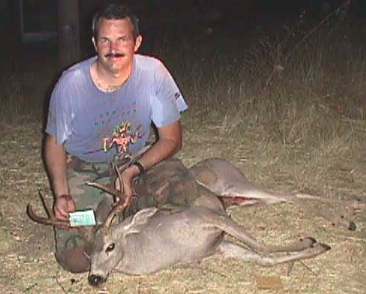
I called Al on the radio to let him know I had one. Although I was quite a ways from the road, dragging this deer out was easier than the pigs I had gotten before. It was down hill and there were some nice built in carrying handles on top of his head. By the time I got down to the road and met Al it was still hot and I was pretty tired. I told him to remind me never to go backpacking for elk. For some reason just because I got this deer after a few hours in the field on the first day of the hunt and got a pig in the first hours of a previous hunt. Al now thinks I'm good at this hunting stuff. Since it seems I get whatever I go after at his place. He wants me to come up for cape buffalo or elephant next time. I don't know about that, after all these years of frustration I'm happy enough with my deer.
If Dale come up and gets a a Cape Buffalo, the next hunt will be for a Unicorn. That should take a while. Varmint Al
![]()
HUNTING WITH DOGS
IN FINLAND; SUCCESSFUL TECHNIQUES FOR MOOSE AND WHITETEAILS
By Ralf Sontag of Finland
I put these lines together for Varmint Al. We have a common interest in hunting, reloading and shooting sports and Al thought there might be many others out there that might find these thoughts interesting and maybe even useful in some way. If any of you out there find the ideas that I put forward interesting please let me know what you think.
The whitetails that we have in Finland were introduced in the wild by a Finn that emigrated to Virginia in the US, made it big and brought over some whitetails to the old country as a favor to fellow hunters. The whitetails are now doing fine and they thrive all over the coastal regions and the southern parts of Finland in increasing numbers. They have become a familiar part of the Finnish wildlife during the past 60 years. The hunting museum of Finland has an exhibit about whitetails if you would like to have more information. Don't worry about the language. English is available to some extent and there are some nice pictures.
In 1999 the annual license count is about 11,300 and since you are allowed to take two does for each adult license the total number of animals taken will be slightly more or approximately 12,000 deer taken each season.
I have visited the US and Canada several times and I have gradually familiarized myself with the hunting practices overseas. My understanding is that you don't use dogs nearly as extensively as we do over here in Finland or any of the Scandinavian countries for that matter. We hunt moose with dogs that approach the moose and tries to keep it from moving forward by running around it in circles. As long as the moose is standing the dog will bark vigorously thus covering the noise that the approaching hunter is making and keeping the moose occupied with the dog rather than the approaching hunter. It is of course elementary to approach from downwind and as quietly as possible. If the moose gets scared and decides to move in spite of the dogs efforts the dog will follow the animal quietly. If the dog barks as the moose is running this will scare the moose too much and the animal will move too far away. The idea is too keep the moose from moving and if it moves anyway the hunter following the dog (usually one or two hunters follow the dog) tries to direct the movement towards the hunters waiting quietly on nearby hillsides or well-known moose trails.
The whitetails don't allow a dog to approach them and they won't stop and let the dog run around them. This has encouraged the hunters to find other ways. In many cases you use beaters that line up and walk through a prospective deer area in a line or make a sweeping movement towards the hunters. Also you might want to wait by a farm field with crops still available for deer that turn up to feed. A more recent method is to use a dog that moves slowly along the deer's trail and keeps barking while it moves further along the trail sticking with the same deer all day if necessary. This resembles the rabbit hunts or foxhunts with one dog following the rabbit or the fox barking as it runs along. This is very exciting and many hunters can enjoy the hunt as they can all hear the dog. It is absolutely crucial to keep very quiet and still as the deer tries to pick up any alarming noise or movement as it runs along trying to avoid the noisy dog following it all over the place wherever it goes. During the rut some big bucks are not afraid of the dog and they might initially refuse to move. As the dog approaches and starts barking the deer will get nervous. Even the biggest bucks will move away at the very latest when they can pick up the noise or the scent of the approaching hunter following the dog. If you are lucky they sometimes stay until you can see them and you might have a chance to shoot.
When the dog finds the deer or a fresh trail it follows the trail closely and barks as it goes. If you follow the dog and you know the territory well you can now position yourself in order to prevent the deer from escaping. The goal is of course to intercept the deer's path and shoot when the animal arrives. Alternatively you can try to direct the deer towards the rest of the hunters waiting for the deer to turn up. They are standing quietly usually on hilltops or in specially placed towers keeping a keen eye on the surrounding terrain. As I'm sure many have experienced it is not always easy to detect a deer even if it is moving around.
This kind of deer hunting is very exciting. Several people can participate and there is a lot of tactics involved. If somebody has a long range rifle he can stay at a hill or a tower where long ranges are expected and somebody else with a rifle equipped with iron sights can take the brushy terrain.
The weather is a very important factor as is the time of year. If the rut is still on the bucks are not moving along the trails as expected but they can make strange loops as they pick up the scent of a prospective mate. Later in the season the weather might be clear, cold and there is still no snow. Under these conditions the deer are very nervous. They can hear the hunters very well and in many cases they move away well before the hunter has any chance of spotting the deer. As the snow arrives everything changes again. You can see which trails are in use and you can track the deer before you put the dog out. Perhaps surprisingly the snow doesn't affect the dogs work too much. Sure it might become slower if the snow is soft, but in many cases it is only the surface that is soft. The underlying layers are tough enough to carry the dog but the deer will fall through. You end up with a situation that is very favorable for the dog. Foggy and rainy weather or wet snow with little or no wind tends to be the days when you are most likely to succeed.
As the hunters keeps still and are looking for approaching deer they can hear the dog and suddenly you can hear the deer approaching only just out of sight or at a bad angle. Then you need to keep very still in order to allow your nearby friend to maybe have a try or wait for the deer to make a turn and come up close and maybe this time show itself. If you move when the deer passes it will most probably keep you in mind and avoid that spot during the rest of the day. Also since the dog moves comparatively slowly the deer approaches the hunter at a limited speed rather than in full speed and jumping up and down. This allows for controlled shot placement and selective hunting provided that you can keep your head clear at all times.
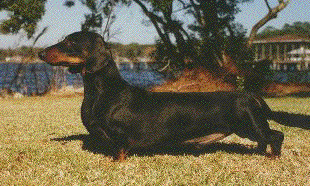 In
order not to scare the deer too much the use of big dogs is prohibited. For deer you are allowed to use dogs
that have a max height measured by the front legs of max 28 cm. The only dog to fulfill this restriction is
the dachshund or the "wienerdog". I have a couple of these myself. My black bitch (smooth haired
black and tanned, 3 years old) took a dozen whitetails this season. Among these was an eleven pointer with a
weight of 85 kg (bones + meat only, guts+hide+head not included). Not bad for a 9,5 kg dog?
In
order not to scare the deer too much the use of big dogs is prohibited. For deer you are allowed to use dogs
that have a max height measured by the front legs of max 28 cm. The only dog to fulfill this restriction is
the dachshund or the "wienerdog". I have a couple of these myself. My black bitch (smooth haired
black and tanned, 3 years old) took a dozen whitetails this season. Among these was an eleven pointer with a
weight of 85 kg (bones + meat only, guts+hide+head not included). Not bad for a 9,5 kg dog?
In January 2001 the dog brought on a whole group of deer during the last days of the season. There were seven animals traveling in the snow in a long row one after the other. I could see them and study them closely for several minutes as they approached without them having any idea of me and my intentions. I took the very last one with a shot behind the shoulder blades. The hit was a bit too far back. I estimated the needed advance wrong even if the deer wasn't moving very fast. The distance was the cause of it all exceeding 130 m. This was much more than I ever expected and so the hit was a bit too far back. The deer dropped almost immediately anyway, so all I had to do was to approach and put a second bullet in the head/neck area. Without the dog any of this would not have happened. Even if the hit would have been worse and the deer would have went on for say several hundred meters or so the dog would have found the deer immediately anyway. More on the dogs click here: Smooths
Al raised the question about introduced species and environmentalism and how the environmentalists feel about introduced species such as the whitetails. In this case they were introduced sometimes after WWII, that is 60 years ago so I guess there wasn't much environmentalism in those days. This winter there has been a discussion in our local papers about foreign species such as deer, mink, North American Beavers and raccoon dogs. The raccoon dog (I don't know if this is the correct name for this animal) looks a bit like the raccoon but is not related to it in any way. The size is somewhere between a badger and a raccoon and it has spread to Finland from the east from Russia where it was kept in farms in large numbers to produce fur. It lives much as a badger and we hunt it in the same way with dogs that are small enough to go into the den and brave enough to face an adversary that might be considerably heavier than the dog with sharp teeth and claws. The dog must also be clever enough not to get killed in the process or let the badger close the passages in the den in front and back of the dog. The discussion is e.g. about how our domestic beaver can be kept from breeding with the introduced beavers and which ones are going to survive. Anyway some of these animals were introduced on purpose (deer, beaver) and some simply escaped from captivity (mink, raccoon dog) and all of these are now spreading within Finland and moving on into neighboring countries such as Sweden. There has been increasing reports of raccoon dogs in Sweden during the past decades.
I have one more note about using hunting dogs in general. When I visited northern Ontario last fall the local hunters said that they had tried several dogs that were imported from Europe. They said that they seemed to work OK but the bears and wolves killed them or the moose were so aggressive and large as compared to our moose that they killed the dogs. Also the terrain was brushier and the dogs don't have the space they need to "work" the moose which makes it easy for the moose to kill the dog. So the idea was good but you don't look forward to training a new dog for every season.
It would be interesting to know if anybody has experience of this in areas with less large predators and a more suitable terrain. Also the details of the dogs used (breeding, training etc…) are of great importance. Sometimes it might also be a good idea to use several dogs rather than a single one.
I think there are regulations about the use of dogs in the US. This is probably also a major reason why dogs aren’t that popular in North America. It is very important to note the difference in the two kinds of dogs I have described. There was the dog that tries to keep the animal from moving and there was the dog that tries to keep the animal moving. On the latter ones we have very strict regulations on the size of the dog as I explained earlier. It isn't very sensible to put a big fast dog on a moose and listen to the dog taking off with the moose for several kilometers or miles as well for that matter. If you have a dog that you are training to hunt hares and foxes and it shows repeated interest towards deer and moose you either retire it to household duties as a pet or put it down.
Another aspect is that the hunting
is usually taking place after the rut is finished. I think the North American hunt is timed to coincide with
the rut. In Finland we try to avoid this in order to reserve enough time for the animals to reproduce. It
might be that the moose are more aggressive in the middle of the rut and that they are more prone to attack
and kill dogs. Email Ralf Sontag
NERD JOKE.... This truck driver hauling a tractor-trailer load of computers stops for a beer. As he approaches the bar he sees a big sign on the door saying:
"NERDS NOT ALLOWED -- ENTER AT YOUR OWN RISK!"
He goes in and sits down.
The bartender comes over to him, sniffs, says he smells kind of nerdy, asks him what he does for a living. The truck driver says he drives a truck, and the smell is just from the computers he is hauling. The bartender says OK, truck drivers are not nerds, and serves him a beer.
As he is sipping his beer, a skinny guy walks in with tape around his glasses, a pocket protector with twelve kinds of pens and pencils, and a belt at least a foot too long. The bartender, without saying a word, pulls out a shotgun and blows the guy away. The truck driver asks him why he did that. The bartender says not to worry, the nerds are overpopulating the Silicon Valley, and are in season now. You don't even need a license, he said.
So the truck driver finishes his beer, gets back in his truck, and heads back onto the freeway. Suddenly he veers to avoid an accident, and the load shifts. The back door breaks open and computers spill out all over the freeway. He jumps out and sees a crowd already forming, grabbing up the computers. They are all engineers, accountants and programmers wearing the nerdiest clothes he has ever seen. He can't let them steal his whole load. So remembering what happened in the bar, he pulls out his gun and starts blasting away, felling several of them instantly.
A highway patrol officer comes zooming up and jumps out of the car screaming at him to stop.
The truck driver said, "What's wrong? I thought nerds were in season."
"Well, sure," said the patrolman, "But you can't bait 'em."
BULL MEDICINE.... A rancher needs a bull to service his cows but needs to borrow the money from the bank. A banker lends the farmer the money, and stops by the following week to see how his investment is doing.
The farmer complains that the bull just eats grass and won't even *look* at the cows. The banker suggests that a veterinarian have a look at the bull.
The next week the banker returns to see if the vet helped. The farmer looks very pleased: "The bull has serviced all my cows, broke through the fence, and has serviced all my neighbor's cows."
"Wow," says the banker, "what did the vet do to that bull?"
"Just gave him some pills," replied the farmer.
"What kind of pills?" asked the banker.
"I don't know," says the farmer, "but they taste sort of like peppermint."
WHAT'S IN A NAME?.... A guy walked into a pub and immediately noticed a young lady at the bar on her
own. After a couple of drinks he decided to
offer her a drink and make small talk. She accepted.
"What's your name?" he asked her. "Carmen," she replied.
"That's a nice name. Did your mother or father name you that?"
"Neither. I changed my name when I was eighteen from Sharon to Carmen."
"Why did you do that?" he asked.
"Well," she explained, "I like men and I like cars, so that is how I got my name. What's your name?"
"Beerpussy," the man replied.
THE BAD BEAR.... A bear walks into a bar in Billings, Montana and sits down. He bangs on the bar
with his paw and demands a beer. The bartender approaches and says, "We don't serve beer to bears in bars
in Billings"
The bear, becoming angry, demands again that he be served a beer. The bartender tells him again, more
forcefully, "We don't serve beer to belligerent bears in bars in Billings"
The bear, very angry now, says, "If you don't serve me a beer, I'm going to eat that lady sitting at the
end of the bar."
The bartender says, "Sorry, we don't serve beer to belligerent, bully bears in bars in
Billings."
The bear goes to the end of the bar, and as promised, eats the woman. He comes back to his seat and again
demands a beer.
The bartender says sorry, we don't serve beer to belligerent, bully bears in bars in Billings who are on
drugs."
The bear states, "Sorry I'm not on drugs."
The bartender says, "You are now...... That was a barbitchyouate."
YOUNG FIREFIGHTER.... A fire fighter is working outside the station when he notices a little girl in
a little red wagon with little ladders on the sides, a garden hose coiled in the middle, and wearing a fire
fighter's helmet. The wagon is being pulled by her dog and her cat.
"That sure is a nice fire truck," the fire fighter says with admiration.
"Thanks," the girl says.
The fire fighter takes a closer look and notices the girl has tied the wagon to her dog's collar and to the
cat's testicles.
"Little Partner," the fire fighter says, "I don't want to tell you how to run your rig, but if
you were to tie that rope around the cat's collar, I think you could go faster."
The little girl replies thoughtfully, "You're probably right, but then I wouldn't have a siren."
THE RIBBONS.... A couple had a dog that snores. So the wife goes to the vet for help. The vet tells
the woman to tie a ribbon around the dog's testicles and he will stop snoring. "Yeah right!" she
says.
A few minutes after going to bed, the dog begins snoring as usual. The wife can't sleep; so she goes to the
closet, grabs a piece of red ribbon and ties it carefully around the dog's testicles. Sure enough, the dog
stops snoring! The wife is amazed!
Later that night, her husband comes home drunk. He climbs into bed, falls asleep, and begins snoring. The wife
thinks maybe the ribbon will work on him, too. So she goes to the closet again, grabs a piece of blue ribbon,
and ties it around her husband's testicles. Amazingly, it also works on him! The woman sleeps soundly.
The man wakes from his drunken stupor and stumbles into the bathroom. While he is standing in front of the
toilet, he glances in the mirror and sees a blue ribbon tied around his privates.
He is very confused. When he walks back into the bedroom, he sees the red ribbon tied to his dog's testicles.
He shakes his head, looks at the dog and says, " I don't know where we were or what we did; but, by God,
we got first and second place!"
AT A RESTSTOP.... I was barely sitting down when I heard a voice from the other stall saying:
"Hi, how are you?"
I'm not the type to start a conversation in the men's restrooms at a rest stop but, I don't know what got into
me, so I answered, somewhat embarrassedly: "Doin Just Fine!"
And the other guy says: "So what are you up too?"
What kind of question is that? At that point, I'm thinking this is too bizarre so I say: "Uhhh I'm like
you, just traveling east!"
At this point I am just trying to get out as fast as I can when I hear another question.
Can I come over to your place after while?
Ok, this question is just wacky but I figured I could just be polite and end the conversation.
I tell him, "Well, I have company over so today is a bad day for me!"
Then I hear the guy say nervously.......
"LISTEN, I'll have to call you back. There's an idiot in the other stall who keeps answering all my
questions!"
A GOOD GUESS.... A shepherd was herding his flock in a remote pasture when suddenly a brand-new BMW
advanced out of the dust cloud towards him.
The driver, a young man in a Broni suit, Gucci shoes, Ray Ban sunglasses and YSL tie, leaned out the window
and asked the shepherd, "If I tell you exactly how many sheep you have in your flock, will you give me
one?"
The shepherd looked at the man, obviously a yuppie, then looked at his peacefully-grazing flock and calmly
answered, "Sure."
The yuppie parked his car, whipped out his IBM Thinkpad and connected it to a cell phone, then he surfed to a
NASA page on the Internet where he called up a GPS satellite navigation system, scanned the area, and then
opened up a database and an Excel spreadsheet with complex formulas. He sent an email on his Blackberry and,
after a few minutes, received a response.
Finally, he prints out a 150 page report on his hi- tech, miniaturized printer then turns to the shepherd and
says, "You have exactly 1,586 sheep".
"That is correct, take one of the sheep," said the shepherd.
He watches the young man select one of the animals and bundle it into his car. Then the shepherd says:
"If I can tell you exactly what your business is, will you give me back my sheep?"
"OK, why not," answered the young man.
"Clearly, you are a consultant" said the shepherd.
"That's correct," says the yuppie, "but how did you guess that?"
"No guessing required," answers the shepherd. "You turned up here, although nobody called you.
You want to get paid for an answer I already knew, to a question I never asked, and you don't know crap about
my business. Now give me back my dog".
A HELPFUL SUGGESTION.... A little boy got on the bus, sat next to a man reading a book, and noticed
he had his collar on backwards. The little boy asked why he wore his collar that way.
The man, who was a priest, said, " I am a Father."
The little boy replied "My Daddy doesn't wear his collar like that."
The priest looked up from his book and answered "I am the Father of many."
The boy said, "My Dad has 4 boys, 4 girls and two grandchildren and he doesn't wear his collar that way.
The priest getting impatient said "I am the Father of hundreds," and went back to reading his book.
The little boy sat quietly...but on leaving the bus he leaned over and said, "Well, maybe you should wear
your pants backwards instead of your collar."
A FRIENDLY LIFT.... At the bus stop In a busy city at a
crowded bus stop, a beautiful young woman was waiting for the bus. She
was decked out in a tight leather mini-skirt with matching tight
leather boots and jacket.
As the bus rolled up and it was her turn to get on the bus, she became
aware that her skirt was too tight to allow her leg to come up to the
height of the bus' first step. So, slightly embarrassed and with a
quick smile to the bus driver, she reached behind her and unzipped her
skirt a little thinking that this would give her enough slack to raise
her leg.
Again she tried to make the step onto the bus, only to discover she still could not make the step.
A little more embarrassed, she once again reached behind her and
unzipped her skirt a little more. And for a second time she attempted
the step - and once again, much to her chagrin, she could not raise her
leg because of the tight skirt.
With a coy little smile to the driver, she again unzipped the offending
skirt to give a little more slack and again was unable to make the step.
About this time the big Texan who was behind her in the line picked her
up easily from the waist and placed her lightly on the step of the bus.
Well, she went ballistic and turned on the would-be hero, screeching at
him, "How dare you touch my
body! I don't even know who you are!"
At this the Texan drawled, "Well ma'am, normally I would agree with
you, but after you unzipped my fly three times, I kinda figured that we was friends."
SPIDERS IN A TEXAS GARDEN.... A father watched his daughter playing in the garden. He smiled as he
reflected on how sweet and innocent his little girl was. Suddenly she just stopped and stared at the ground.
He went over to her and noticed she was looking at two spiders mating. "Daddy, what are those two spiders
doing?" she asked. "They're mating," her father replied.
"What do you call the spider on top, Daddy?" she asked. "That's a Daddy Longlegs." Her
father answered. So, the other one is a Mommy Longlegs?" the little girl asked. No," her father
replied. "Both of them are Daddy Longlegs."
The little girl thought for a moment, then took her foot and stomped them flat.
"That might be OK in California and Massachusetts, but we're not having any of that here in Texas"
THE MAYONNAISE JAR.... A professor stood before his philosophy class and had some items in front of
him. When the class began, wordlessly, he picked up a very large and empty mayonnaise jar and proceeded to
fill it with golf balls.
He then asked the students if the jar was full. They agreed that it was.
So the professor then picked up a box of pebbles and poured them into the jar. He shook the jar lightly. The
pebbles rolled into the open areas between the golf balls. He then asked the students again if the jar was
full. They agreed it was.
The professor next picked up a box of sand and poured it into the jar.
Of course, the sand filled up everything else. He asked once more if the jar was full. The students responded
with an unanimous "yes."
The professor then produced two cans of beer from under the table and poured the entire contents into the jar,
effectively filling the empty space between the sand. The students laughed.
"Now," said the professor, as the laughter subsided, "I want you to recognize that this jar
represents your life. The golf balls are the important things--your family, your children, your health, your
friends, your favorite passions--things that if everything else was lost and only they remained, your life
would still be full.
"The pebbles are the other things that matter like your job, your house, your car. The sand is everything
else--the small stuff.
If you put the sand into the jar first," he continued, "there is no room for the pebbles or the golf
balls. The same goes for life. If you spend all your time and energy on the small stuff, you will never have
room for the things that are important to you. Pay attention to the things that are critical to your
happiness. Play with your children. Take time to get medical checkups Take your partner out to dinner. Play
another 18.
There will always be time to clean the house, and fix the disposal.
 "Take care of the golf balls
first, the things that really matter.
"Take care of the golf balls
first, the things that really matter.
Set your priorities. The rest is just sand."
One of the students raised her hand and inquired what the beer represented. The professor smiled. "I'm
glad you asked. It just goes to show you that no matter how full your life may seem, there's always room for a
couple of beers.
THE BUFFALO THEORY.... (From an episode of 'Cheers', Cliff is seated at the bar describing the
Buffalo Theory to his buddy, Norm.)
"Well you see, Norm, it's like this. A herd of buffalo can only move as fast as the slowest buffalo. And
when the herd is hunted, it is the slowest and weakest ones at the back that are killed first. This natural
selection is good for the herd as a whole, because the general speed and health of the whole group keeps
improving by the regular killing of the weakest members.
"In much the same way, the human brain can only operate as fast as the slowest brain cells. Now, as we
know, excessive intake of alcohol kills brain cells. But naturally, it attacks the slowest and weakest brain
cells first. In this way, regular consumption of beer eliminates the weaker brain cells, making the brain a
faster and more efficient machine. And that, Norm, is why you always feel smarter after a few beers"
Q.E.D.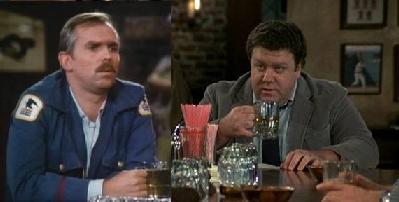
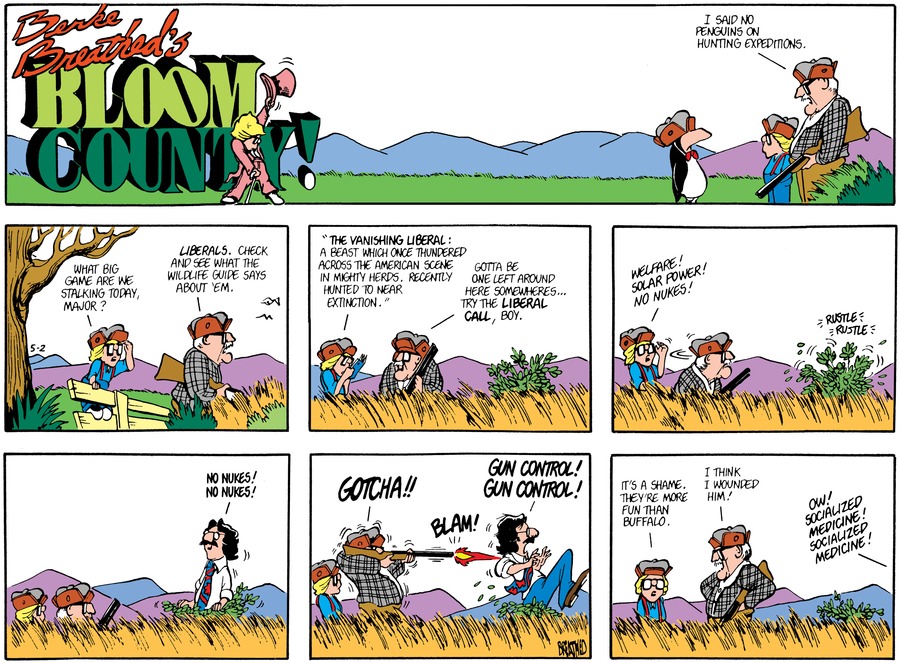
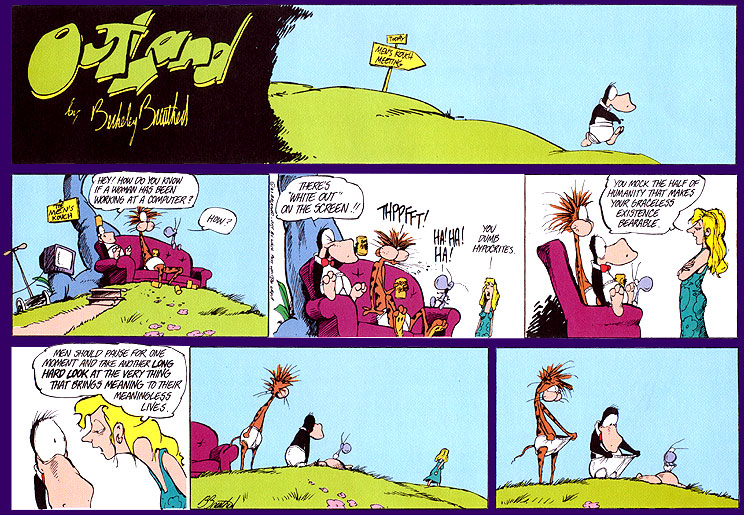
A POOR MEMORY?.... An old man approached the White House from the park across Pennsylvania Avenue where he'd been sitting on a park bench. He spoke to the US Marine standing guard and said, "I'd like to go in and meet with President Clinton." The Marine looked at the man and said, "Sir, Mr. Clinton is no longer president and no longer resides here." The old man said, "Okay" and walked away.
The following day, the same man approached the White House and said to the same Marine, "I would like to go in and meet with President Clinton." The Marine again told the man, "Sir, Mr. Clinton is no longer president and no longer resides here." The man thanked him and again, just walked away.
The third day, the same man approached the White House and spoke to the very same US Marine, saying "I
would like to go in and meet with President Clinton." The Marine, understandably agitated at this point,
looked at the man and said, "Sir, this is the third day in a row you've been here asking to speak to Mr.
Clinton. I've told you already that Clinton is no longer president and no longer resides here. Don't you
understand?"
The old man looked at the Marine and said, "Oh, I understand. I just love hearing it."
THE MARINE SNAPPED TO ATTENTION, SALUTED AND SAID, "SEE YOU TOMORROW, SIR!"
DIAMONDS.... Some days are diamonds and some days are stones. Some days are just a clod of dirt. Today was a 2 carat diamond. I had a chance to take a big Blacktail buck. He was perfect, with large symmetric horns and a heavy full body. I sat down and put up my Bi-Fur-Pod and had him in the scope and decided it would be better if he would do his thing with the does and pass on those good genes. I watched him walk over the top of a hill, stiff stepping out of sight. Later, I jumped a smaller buck with lesser horns and let him go also. Walked down the hill and setup a stand to call coyotes and jumped 5 wild pigs on the far hillside at about 120 yards. They were 100 pounders and calmed right down in a few seconds. They slowly rooted their way across the hillside. It was 1.5 miles back to the cabin and they were just too big to haul back alone, besides I like the 50 pounders better. I didn't get anything, but sure had plenty of chances and completely enjoyed the morning. A Diamond of a morning!
The
"Accidental" Deer
by Mëgen / Marge Diekow
Having grown up having the run of several adjoining farms and woodlands and surrounded by all male cousins
and young uncles, I must admit I grew up quite a "tomboy"! By age nine, I could run as fast, jump as
far, shoot a pellet gun or throw a knife as well as they. Although I'd been safely "re-feminized"
over the years, it seemed natural that I still be included in a few of their hunting trips -- this one, during
Bow Deer Hunting season.
Exhausted by the bitter cold and fruitless near-dawn(!) to near-dusk trekking along snow-less northwoods
trails, we dragged into our tent-camp early, added warmer jackets, and began stowing gear and cleaning up. The
second team of our seven-person hunting party arrived mere minutes after us, reporting even worse luck than
ours: they had not even seen a deer this whole first day! We sat as near the fire pit as we dared, scraping
thick layers of mud from our boots and speculating in low, weary voices how best to achieve success on Day
Two.
I was one of two eyeglass-wearing members of our party and, in lifting my head to reply to a question from my
young nephew for whom this was a first hunt, I picked up an image of "something moving behind me" on
the inside of my left eyeglass lens. Distorted by the lens' corrective curvature, it took me a startled moment
to identify it as a deer.
My first thought was to whisper, "Everyone freeze!" and let a more seasoned hunter take a shot, but
I realized everyone had loosened their bowstrings and secured their arrows -- except for me! ...One thing I
was unable to do easily was string/unstring the sixty-pound bow I'd borrowed -- I had to do it "kiddie-style",
stepping through and using my full body weight to adequately flex the bow and I wasn't about to let my male
companions tease me about it, so planned to wait until they'd retired -- which looked to be any moment now --
and was dawdling over cleaning my boots.
Considering this, and almost without further conscious thought - and while continuing my answer to my nephew's
question-- I reached discreetly past my extended right leg, caught an arrow's fletching between my fingertips;
and, in one unexpectedly fluid motion, managed to secure my bow, transfer it to my left hand, nock the arrow
as I brought the bow into position and rise and pivot on my left knee. Seeing the confused animal's eyes fix
on me and its ears twitch in my direction, I too-hastily pulled and let fly -- yet put an arrow cleanly
through the base of his neck.
The camp went silent. I thought I'd missed -- the deer continued his small, tentative steps toward our camp.
Then he opened his stance, staggering like a newborn to keep his footing; took four- five more steps toward
us; and finally sank with unbelievable grace to his knees, neck extended as if still straining forward ...then
died looking up into the eyes of my sixteen-year-old nephew who now knelt beside me with his back to the
fire.
I only vaguely recall the celebration, carcass-dressing, etc. which followed; but will never forget exactly
how it felt to make that kill, to hear -almost feel-- my arrow thunk into that solid body.
And neither, I guess, will my nephew forget that near-dusk shared adventure; the way the light faded from the
animal's eyes; the way its every breath produced a smaller cloud of mist -- to this day, nearly twenty years
later, he will carry only a camera into the woods each year....
Al, several months back I purchased a 7mm Lazzeroni Tomahawk barrel from Virgin Valley Custom. I had been
having several problems with the ejector in the barrel, and turns out it was too long, and was causing some
problems with ejection of the spent casing. I removed it and gently worked it down to a smooth surface,
and polished it with Flitz... Works like a million bucks!
How do you polish the chambers in your Encore rifle? (Q-tip & drill or a dremel?) My Tomahawk has just a
hideously rough chamber, and the casings look mighty crappy when fired in that chamber (sandblasted looking
with rings around the brass from chamber cutting). I read your chamber polishing portion of the site, and I am
thinking about polishing my chambers.. I want to polish the chamber but don't know how to go about it. Any
information is appreciated.
I reloaded for my tomahawk using tips and instructions extracted mostly from your reloading web page. I found
that your methods of reloading are easy to follow and precise. I made the best ammunition ever by following
your instructions!! Thanks so much for taking the time to post all of your knowledge on this website.. I
access it frequently and can't say enough about what a great resource it is for any shooter...beginner to pro.
Attached is a picture of a pronghorn that was shot in Northern Colorado on the 29 Sept 2001 (may take some
time to load). I made a long stalk on him while he was chasing a coyote with a smaller buck and a doe, and not
paying attention to me!! (only time a coyote is really useful). One shot with the Tomahawk did him in.. What
Excitement!!
Al, here is the story of my buck:
The evening of September 28th brought me excitement thinking about how many large bucks roamed the private land I would be able to hunt the next morning. It has taken me 4 years to draw a tag here in Northern Colorado; a place I have taken smaller bucks, but dreamed of more. Jerry, a good friend of mine, told me of a large antelope buck he had seen a week previous while working cattle on horseback. The land here is seemingly flat and you wouldn't think a mouse would be able to hide here...but you'd be wrong. This area holds some of the largest mule deer and antelope bucks in Colorado. Just 2 years ago, some friends of mine killed 2 large mule deer bucks 10 miles east of here. The first a 7x7 with a 32.5" inside spread, and the other a 9x6 non-typical with a 5.5" drop tine on the right antler 33" inside spread.
 Saturday the 29th brings a
beautiful red sunrise, and a brisk breeze across the plains, and the hope of connecting with a good buck. The
first knoll we drive over we spot a herd about 300 yards with a one-horn buck, as we proceed through the
pasture we discover a large red canyon with gullies and washes; great potential for hiding antelope. It is
8:30 now and we have seen 13 mediocre bucks, the smallest of which have horns in the 10-13 inch class; any one
of which I could have taken, but come on...It's only the first day!!
Saturday the 29th brings a
beautiful red sunrise, and a brisk breeze across the plains, and the hope of connecting with a good buck. The
first knoll we drive over we spot a herd about 300 yards with a one-horn buck, as we proceed through the
pasture we discover a large red canyon with gullies and washes; great potential for hiding antelope. It is
8:30 now and we have seen 13 mediocre bucks, the smallest of which have horns in the 10-13 inch class; any one
of which I could have taken, but come on...It's only the first day!!
We now venture to another plot of land with a large torn flat-top hill, which offers us a good place to
glass the country. As we drive over the top, a very wide and stout-looking majestic buck startles from his bed
and stops broadside...Should I shoot? I glass him some more and decide to let him go. The more I think about
letting him go, the more I get bothered, but then I think to myself "how many people in this world get an
opportunity to do this?" We move on.
9:13 is the time I last looked at my watch when we drive through a ravine and park. As we come up over the top
of the lip of the ravine; there stands the stout-looking buck, and to the right, another buck that blows him
away. "We need to try for that buck" I whisper to Jerry. We laid there in the dust of the plains and
made our game plan for an approach on the bucks, which now stand 575 yards distant. Jerry says "let's use
this small wash to get a better look at that other buck". We close the distance to 400 yards, but the
distance is too far with a 25 mph crossing wind for a shot, but I make the determination that we would make a
stalk on the larger buck. We approach the flat-topped hill as he feeds over the top onto the other side. Jerry
and I run like hell to cover some distance before we catch this buck's attention. About that time the large
buck came running from the other side of the hill and ran across the pasture at 60 mph. He ran under a fence
and proceeded to take another smaller buck's harem of ladies (2 does), and beat the heck out of him. They
crossed again and came trotting across the pasture and over the hill again.
Five minutes of glassing brought the animals running over the hill again, but why? "Nobody else hunts this property" says Jerry. "Look, a coyote!" exclaims Jerry. The antelope surrounded the coyote and began to kick the hell out of him... I will tell you now that I have yet to see a coyote that can outrun a pronghorn! We watched as the coyote bared his teeth with his ears back; tail between his legs. The antelope harassed him about 7 minutes before he ran over the hill with the antelope not far behind. It was now or never.. Jerry and I ran to get on top of the hill knowing the buck was on the other side. We came to the crest of the hill and couldn't see a thing until Jerry peeked over the other side of the hill and dropped like his arms gave out " Tad... that buck is RIGHT BELOW US FEEDING!!" says Jerry. I peer over the hill and all I see is 2 prongs. I cock the hammer on my Virgin Valley Custom Encore in 7mm Lazzeroni Tomahawk and peer through the Burris scope as the buck gets wind of us. The next few moments seemed like an eternity....
The buck was a downhill shot (about 70 yds): a 75 degree angle and I missed his spine by 1/4 of an inch shooting a foot high! ...DAMMIT! I totally forget to hold low shooting downhill, I popped open the Encore action, slammed home a fresh round, and picked up the buck running now at 200+ yds waiting for him to stop for a shot. I have practiced endlessly at long range shooting because most pronghorn I have taken have been closer to 300 yards (sometimes you just can't get closer). Now this buck was getting into my shooting territory (close to 300 yards counting fence posts). He made the mistake of stopping to run under a barbed-wire fence as I squeeze the trigger between my now pounding heart-beats. THWOCK!! the big boy runs in a semi-circle and staggers a distance before collapsing. His horns measure 15 7/8" on left and 16" on right. What an animal!!! This pronghorn was particularly important for me because it was shot with a custom gun, which I worked hard for, and shot with my own premium manufactured ammunition. I want to sincerely thank Varmint Al for the tips and treasures on shooting and reloading which made this dream possible. I hope you enjoy reading this story as much as I enjoyed telling it.
Enjoyable Memories and Good Hunting From: Tad Stout
First Varmints
by Dave in Texas
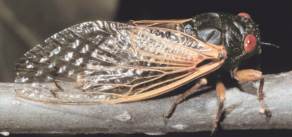
It rained all last weekend; couldn't hunt anything. I got to thinking about my first varmint hunting
adventures. I was the great locust [Cicada] hunter at the age of six. I hunted almost every Summer day. I used
a Daisy BB gun and shot these critters out of the trees and feed them to the ducks. Soon the ducks figured out
the plan and upon seeing me with the gun or hearing the first shots, would come on the run.
Sometimes a locust would not be dead as it fell from the tree and would continue to make a lot of noise. This
noise occasionally would continue even after a duck had swallowed the locust whole. This noise would now be
coming from inside the ducks neck [craw]. Other ducks would now chase this duck, thinking that he was holding
a locust in his mouth. Of course he didn't understand why all these guys were chasing him and sometimes it was
one hell of a rodeo. I've been told that it was quite a sight to see the barefoot kid in the bib overalls
walking around with 6 or 8 ducks, all looking up in the branches of the cottonwood and pisselm trees.
After nearly 50 years, dozens of rifles, thousands of prairie dogs, hundreds of coyotes, a few fox and bobcat,
numerous deer, elk, antelope, one mountain lion, and a bear, on rainy days, I remember most the BB gun, the
locust, and the ducks. Funny.
Got My First Groundhog!
By Kirk in Ohio Sept. 29, 1999
It all began when I bought my Ruger 77/22 Hornet (not the varmint model) with a 3-9X Bushnell back in March.
Started reloading with much help from the Go Go
Varmint Go Message Board and hit the range. Best groups about 2 inches at a hundred yards now but I'm
still working up - I'm at about 75% of max Alliant 2400 and .030 from lands. The 45gr. bullets have
consistently outperformed the 40 gr. bullets. My bench setup is simply a soft sided cooler with just me
supporting the butt. Also use my "Bi-Fur-Pod" courtesy of Varmint Al's advice.
My first two varmint hunting experiences were duds as far as kills but fun nonetheless. First time called in a
mess of crows and missed at 20 yards straight up with my 20 ga. double. Second time overshot 2 groundhogs at
about 100 yards with the Ruger.
The charmed third time came Monday evening. I hit the range in the afternoon and tested the 45 Sierra SP, 40
Nosler SBT, 45 Hornady HP Bee. Amazingly, the HP Bee, a pistol bullet I think, shot the best again but I only
had two left so I zeroed in right on at 100 yds with the 45 gr. Sierra SP.
I went to the Grand River Wildlife Area and setup downwind just inside the woods bordering a plowed Dove field
maintained by the Ohio DNR. (Should I be giving up my spot??). Got settled at about 6:00 PM after making a
hell of a lot of noise (have to work on that). Weather cloudy, South wind, intermittent light rain. Had a
tri-pod seat and my Bi-Fur-Pod shooting sticks, Backwoods Off, binoculars, khaki pants, olive T-shirt, no
jewelry, and a little rubbed dirt on my face. Heard a lot of sounds behind me of course but nothing out in the
field.
After about an hour I was about to give up and do some scouting around with the 20 minutes or so left to
sunset. Then I saw something that hadn't been there before right at the edge of some scrub. Does it always
happen like this? Where the critter just appears and you never see him get there?? Kind of spooky. Anyway, at
first it looked like a big gray pigeon (I live in the city guys). I slowly got the binoculars up and saw a
nice hog standing up. As for distance I really had no idea but figured it was less than a hundred yards. Now
I'm real excited and fumble a bit getting the rifle up on the Bi-Fur-Pod. I look through the scope and there's
kind of a double crosshair because of some plant in front of me is partially in front of the scope. I decide
to use the darker of the two crosshairs and took a few deep breaths to settle down. Got a good smooth squeeze
on the trigger and shot, crosshairs right in his middle. Lost the picture for a split second then back to see
his ass-end tumbling away from me. Couldn't really tell if I got him and waited around about two minutes (felt
like an hour) to see if any more showed up. I walked 65 paces to the spot and saw him dead as doornail about 3
feet from his hole. Got him right under the left forearm. A tobacco-spit size blood splotch and a hole about
the size of a big nickel.
How did I feel? This was the first time I killed something other than a fish or a bug. The adrenaline was
still going and I felt good. There is much work in the process of getting to this point. Fun work to be sure
but you can't just go out and shoot some wild animal without preparation. I looked him over real good and felt
his fur, looked at his nice set of teeth, little hands. This may sound corny but I felt
"appreciative" of the little bugger. I do have some nagging misgivings about not
"harvesting" him-skinning him or eating him (I don't know how to do either one). But as I tossed him
into the woods I figured creatures from the fox to the ant would not let him go to waste. Plus he plays a part
in the process of getting to be a better hunter so clean kills can be made on critters I will eat, like
squirrels and rabbits.
All in all a super time and I can't wait to get out again. On the way out of the woods in the dark I thought I
heard what sounded like a coyote bark.....Oh boy!
FIRE & ICE -- GROUND SQUIRREL HUNT.... The Alturas Fire & Ice ground squirrel shoot, April 1998. Last Tuesday we headed up to Alturas. It is a 350 mile drive north-east from Bethel Island. The clouds were just ahead all the way. We were expecting rain, but about 40 miles from Alturas, the first precipitation occurred. It was hail. We arrived in Alturas abut 3:00PM and checked into the Motel. No tents or campfire cooking. We were going to live well while on the hunt.
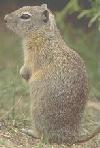
We drove out to the ranches and talked to the farmers and verified our permission to hunt their fields, approximately 2.5 sections. They were happy to see us. We drove over to the south section and were going to test our rifles. I started in the south field with the 223, but I was not doing very well. It was cold and I was having difficulty spotting my hits. I was trying to judge the wind and then I discovered I was 2" high and correcting for wind didn’t help that. About the time I had things corrected, the heavy wind and hail returned and after sitting in the truck for a while, I called the other guys on the ham radio. We decided it was time for happy hour and dinner. It was very cold. It snowed about 2 inches Tuesday night.
Wednesday morning after a good breakfast, we hit the fields at just about 9:00AM. The gloves, long johns, and thermal boots felt good. I had my ear plugs held in with my AM radio headset tuned to Rush Limbaugh. The only way to hunt! The snow was not quite solid cover, so it was still a bit difficult to spot the ground squirrels. They were out crawling all over the place. The young crop was out along with the adults. The adult squirrels are about 9" long and the young are about 5" from nose to tail. That is not a large target at 200 yards. I started the morning with my 17 Ackley Hornet. I was passing up 10 to 50 yd shots and taking shots out to 200 yards with squirrels crawling all around me. After 100 rounds, with the close critters were attacking and I switched to my 22 LR Match barrel and went through 150 rounds before noon. The hail/sleet was coming at about 30 minute intervals and only lasting about 5 to 10 minutes. It was bouncing off, so I would just turn my back to the wind and let it pass. The squirrels were still coming up in between the hail. This is not optimum for hunting. My buddies were hunting in the south section and I could hear them shooting their 223's over Rush in the headset and the wind. By 1:00PM I was really getting cold and a quick call on the ham radio and we all agreed a hot lunch sounded good. After lunch, the front hit and there was not a single drop of rain, but hail, sleet, frozen rain, and snow. We packed it in for the day.
Thursday with full cold gear on we were back in the fields by 9:00AM and it was just broken clouds and cold. The squirrels would come popping out every time the sun hit the ground, then when a cloud would go over, a few stragglers would stay out and the rest just disappeared. I was using the 17 Mach IV and it was right on, but the BSA scope was poor in the bad light. I was doing fairly well with it at 18X, but couldn’t see very much with it cranked up to 24x. I was in an area like an amphitheater with squirrels out to 300 yards for about 200 degrees. I use a short lawn chair and my Bi-Fur-Pod for support. The chair has a pocket on the seat back that easily holds two or three 50-boxes of ammo. I went through 150 rounds only moving about 50 yards. Dick and Lee had found a large colony and were shooting at about 1 minute intervals. They called on the radio and confirmed the hot spot. Then I switched over to my 22 K-Hornet and moved over the top into the next bowl and went through 100 rounds from the top shooting down. I had bypassed lunch and by 5:00PM was starting to get hungry. Also the clouds were only in small patches and I was starting to feel sunburn. I finished off the day with a few 17 Mach IV and decided it was dinner time. I stopped at the drugstore in town and bought some sun block!
Friday morning, Dick and Lee headed home and I was hunting solo. There was not a cloud in the sky. Rush in my earphones and sun block on my face, I hit the north section with the 223 and went through about 173 rounds. The 33 gr. V-Max moly coated bullets with 26.7 gr. of H322 really reach out to 300 yards easily. At first there was not very much wind and it was easy at that distance. After an hour or so, the wind started to kick up and it was variable. I would have wind one direction where I sat and blowing an opposite direction at the bullet impact point. Carefully watching the dust cloud at impact gives good info for the next shot, but not always. When the ground squirrels stand straight up, they are only about 2" wide and 9" tall. That makes a tuff target in the wind. I can judge the drop fairly well, but windage is more difficult. On the very long shots, I was waiting for the squirrels to get back on all four to take the shot. By noon, I went over to another natural amphitheater with short grass and a few trees. This was on the third ranch and was Dick's favorite place, but he was somewhere south of Sacramento by that time. I switched back to the 17 Ackley Hornet and pretty well swept this area clean. A crew of young kids (college kids) drove up. Three were sitting on the hood of the car with their girlfriend driving. They were driving through the fields blasting away. They were getting a few. I stopped and talked to them and showed them the 17 Ackley Hornet and they really thought it was nice. I gave them one of my Varmint Hunting cards and told them to check the web page. I finished off the day with the 22 LR and was getting pretty shot out by 5:30PM. The sun block worked, but it was time for a cool one.
Short lawn chair and Bi-Fur-Pod for a rifle rest and Leica 8x32 BA binoculars.
22 LR Match 22" Contender Carbine barrel, 4-14x by 50mm Leupold, 300 rounds CCI Blazer
17 Ackley-Hornet 22" Contender bull barrel, Weaver 4-16x by 42mm, 200 rounds 20 gr. Berger MEF moly & N-133, 3300 fps
22 K-Hornet 22" Contender bull barrel, 3-9x compact Leupold EFR, 100 rounds 33 gr. V-Max moly & H110, 3050 fps
17 Mach IV 22" Contender bull barrel, 6-24x by 44mm BSA, 150 rounds 20 gr. Berger moly & H322, 3600 fps
223 Mod 700 Rem PSS, 4-18x Sightron, 173 rounds 33 gr. V-Max moly & H322, 3675 fps
Total of 923 rounds with hits averaging about 80%. Approximately 24 hours in the field. That averages to about 38 rounds per hour. Dick and Lee together fired about 500 rounds.
In four days, we only hunted about 10 percent of the ranch land area that we had permission on and probably got about half of the ground squirrels on the area where we hunted. The three of us got about 1,140 total. Using that estimation, there are approximately 21,600 Belding's ground squirrels, sage rats, or picket pins (whatever you want to call them) still running around in the alfalfa fields of those three ranches. That is a lot of squirrels and they do tremendous damage to the fields. Each group have about 3 mounds and clear the tops of a 20' diameter circle of alfalfa and then eat the roots and finally kill the plants. Family groups appear to be about 30 to 50 ft apart. There is a large wildlife preserve in the area and the ranchers are not permitted to use any kind of poison. They have tried traps, vacuum cleaners and various other techniques to control their numbers without success. That is why they are so happy to have shooters. The period from late March to early May is the only shooting time I know of. After the middle of may, the alfalfa is too tall to see the squirrels. There is a few days after each cutting that the grass is short enough and it is possible for a hunt. In the summer and fall hot weather, the squirrels stay underground and essentially hibernate.
The most fun was with the 22 K-Hornet. It is a perfect caliber for this type of shooting. The 3-9x scope was a bit low on magnification, but still worked very well. I was able to spot all of my hits and make corrections for wind and distance. The next best was the 17 Ackley Hornet, but the Weaver scope is not very good at the higher magnifications. I could only spot about half my shots with the 223. Even with the 33 V-Max, the recoil was enough to miss spotting about half the shots with it. For the close in young ground squirrels, the 22 LR is fine out to about 75 yards. But you have to be way out in the back fields because it ricochets once in a while. The 4-14x Leupold is a bit much for a 22 LR, but I need it for low light conditions around the island. It would have been better it that Leupold scope had been on the 223.
While shooting, it is bad when the seagulls move in. They come in large numbers and put all of the squirrels down. Other birds in singles will also put the squirrels down for only a few minutes. We saw a number of red tail hawks, white tailed kites, and golden eagles. The hawks and kites land out in front while the shooting is going on and eat squirrels. They pay no attention to the gunshots. I have shot squirrels 10 or so feet from behind them, so there would be no ricochet, without them even looking up. The eagles land and pick up the squirrels and fly off. The eagles will also attack a hawk and take the squirrel and fly off. We also saw a number of ferrets. I spotted one drag a squirrel down a hole and then head off looking for more. They were also not gun shy. There are a lot of Canada geese up there in the area raising their young too, but not in the alfalfa fields. The farmers put old tires with a plywood bottom on fence posts for them to nest in. That way the coyotes can't get the baby geese. Late Friday, I took a drive up the road to Cedarville and counted 31 mule deer and 3 antelope out in the sagebrush flats. There is a lot of wildlife in the Alturas area.
All in all, it was a good trip. Next year some better glass for the 17 Ackley Hornet and the 223 and more 22 K-Hornet rounds. Hopefully, not so much bad weather would be nice too.!
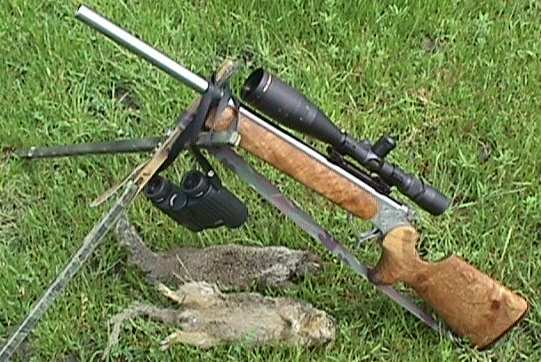
The 17 Ackley Hornet now has a new scope which is much better. The scope is a Nikon 6.5-20x by 44 Matt Finish,
Fine Crosshair.
|
Ode To The Coyote Hunter They loaded their dogs in the pickup truck, |
Surprise Valley Ground Squirrel Hunt
March 1999
By Bob Williamson
Al, we are back from Cedarville. The people are great up there. It is a small community of 10 stores, (3
restaurants, 2 markets, 2 motels, post office, Chevron gas station, Auto Parts, etc).
I stayed at the "Sunrise Motel" which I might point out is as nice as some I've stayed at in bigger
cities. Sue, the owner, couldn't be more friendlier if she tried. My wife stayed at the motel during the days,
while I hunted, and Sue made sure she came over and talked and checked on her each day. Gave myself and my
friend nice ball caps, and upon learning that we were coming back through Reno, gave my wife $3.00 in quarters
to bring her luck (which didn't quite work).
I drove up on March 24th and hit heavy rain from about Williams and it came down hard all the way until I got
to Burney, CA., then it stopped. What a pretty drive up through Burney, Fall River Mills, and Alturas.
Made it to Cedarville about 3:30 PM under very dark skies. Checked in relaxed, went to dinner at the
"Country Hearth Restaurant" and met two fellows from Concord and Walnut Creek. Small world!

Next morning got up and found beautiful skies and the sun brightly shining. I went out to some recently
planted and drug alfalfa fields that Chris Knoch, my rancher, recommended I start on, and found upon arriving
at the fields little squirrel heads poking out of all the boroughs in this 75 acre field. The alfalfa was just
starting to bloom and was only in just starting to come up and the stubble was only 3-4 inches at the thickest
spots. The field was drug clean two weeks ago and there were hundreds of mounds all over.

I setup my bench, (see the photo) and proceeded to knock down one Belding's ground squirrel after another. I
used mainly my Howa 223 (heavy barrel). The 223 does a great job on those little guys. I shot mainly the 40
gr. moly coated V-Max's (27.5 gr. Varget) and under 200 yards was pretty much a gimmie hit. The Howa has a
6x24x 44mm Tasco World Class scope with dot on it, and surprisingly is quite clear and the dot is great for
shots under 300 yards. I tried my 40x in 6mm Rem and it hit everything I shot at using either the 55 Nosler BT
with 42.5 Varget, or the 68 gr. Berger HP using 36.0 gr. of 3031. No 22 LR shots. It seems the road warriors
have hit the fields along the road with the 22's and created a band around the fields along the roads. I'd say
the first day I shot over 80 squirrels (probably only found bodies of 40).
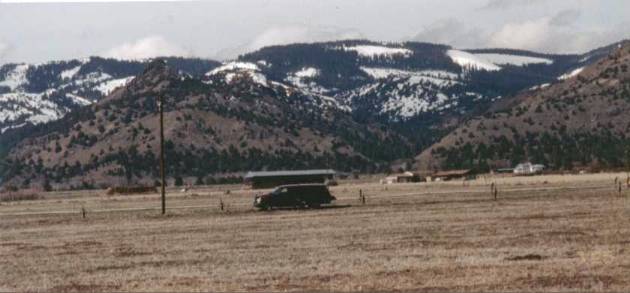
I shot in this field for the morning, went back to the motel and had lunch (it's a whole 3 miles away) then
went back with my wife to shoot some more. In the afternoon the skies really clouded up, it got very windy and
cold and the squirrels weren't as plentiful. The secret is to have sun and warm for them to become active.
The second day the clouds were dark and it was cold and windy all day. It had rained all night so the fields
were wet and hard to drive and walk in without bringing back half the field on your tires or boots. The same
field only brought about 40 kills. After shooting long range, I moved into the center of the field and shot
any that came up on the far side of the fields. That night after dinner, it started to snow.
Saturday, the day of the official squirrel contest, we awoke to have ice and a light dusting of snow on our
cars and the ground. Not to be put off by this small set back, off to the fields we went. Surprisingly, there
were squirrels running around the fields with on and off snow falling. We setup and starting shooting. In the
later morning and afternoon the clouds had all disappeared and the fields started to warm and more squirrels
came out. Again, the 223 worked the best. Easy to shoot, and very hard hitting power on those 10 inch
squirrels. By the end of the day we had found 40 squirrels that we were able to remove their tails for the
contest. I'm guessing we shot 80 but they're nearly impossible to find. Unless you blow them apart at the time
of the hit, they'll crawl back into a hole and you'll never find them. I'd shoot one, see him go straight up
in the air, roll around on his back on the ground (clawing and jumping) then go back to find him later, and
nothing there.
The bar-b-Que. was held at the Modoc County fair grounds. You bring in your tails, and sign in and get a
special "Squirrel Roundup 1999" ball cap. They had some raffles, an auction, and a good steak
dinner.
The winner of the "Stuffed Squirrel" award for the most tails brought in 190 tails, with second
around 120 tails. Sure don't know where they found a fields with that many to shoot on, and then find them
afterwards, but more power to them. The winner must of shot over 240 to find 190. He said he used mainly 22
and 6 BR's. There was 90 shooters entered.
I decided my wife had enough of knitting and was getting cabin fever pretty much, so instead of leaving Monday
as planned, I shot Sunday morning, then left for home around noon. We stopped by Reno so she could try her
luck on some slots for 3 hours before continuing on to Antioch. I met a rancher at the dinner who gave me
directions over to some of his land for an attempt at a coyote. I stayed there over an hour and didn't get
anything to come in or show themselves, so back to squirrels. We went to a different field and shot steady
until noon. Sunday's weather was the best. Clear bright and warm, and the squirrels responded to it quite
nicely. In this field I tried some very long shots with the 223. After going through a lot of 223 ammo,
managed to hit one at 350-400 yards. We got home to Antioch about 10 PM.
Lessons to be learned: When shooting these long fields need you need colored flags setup at various distances
across the fields to allow you to determine the distance and scope settings. A laser Rangefinder would have
been great. Additionally, although we like the high powered variable scopes, when the sun came out and fields
warmed, the mirage was very heavy and the highest power you could use was around 10-12x at the 200 yard plus
shots. I did try a 450+ shot with the 223 only to see the dust fly way short of the target.
In summary, great fun, nice people and worth going. I was a little disappointed to only shoot 50-70 squirrels
a day. I had heard of reports of 300-500 a day was common. To do that a person needs to have a very private
ranch, and great weather. Possibly by mid April would be better. A lot of shooters came up the previous two
weeks before the "shoot" and hit the fields very hard according to the locals.
Sorry about the length of this essay, but wanted to give you all the details. Attached are some pictures of my
setup, the fields, and the beautiful setting in the "Surprise Valley" that we shot in. Bob
Surprise Valley Ground Squirrel Hunt
March 2000
By Bob Williamson
Al,
Just came back from Cedarville last night. One thing to be learned is that you certainly can't judge the
weather up there by what's going on in the bay area.
Before leaving for Cedarville my mouth was watering because of the close to 80 degree temperature we were
experiencing here in the bay area. I imagined short sleeve shooting and millions of squirrels out running
around sunning themselves in the fresh blooming alfalfa.
On the drive up last Thursday I noticed very dark clouds to the east of Interstate 5. The closer I got to
Redding the darker and more intense they appeared. Mind you, I'm in sunshine all the way to Redding.
After heading east on Hwy 299 I started seeing rain, then about Fall River Mills light snow flurries, but no
fear, it was melting. Now upon reaching Adin Pass at 5,000 ft the snow was sticking but I made it over with no
problem. Arriving in Alturas it started to snow. Now I'm starting to get a tad worried, I have Cedar Pass to
go over at 6,000 ft. Sure enough, snow plows working the road, my truck a little light on traction, and people
skidding. Made it over alright, but was thinking to myself, Al always says I go a little too early and the
weather could be a problem.

I arrived in Cedarville to the tune of blowing snow and sleet. Being the optimist, instead
of checking into the motel, I drove to some of my fields. Not a creature stirring. Great, 6.5 hour drive to
watch television in the motel room.
I checked in to my room started to watch television and said to myself, if I clean out my gear from the camper
shell I could shoot from inside and stay warm. What the heck, just one or two squirrels would be nice.
Loaded up a couple of guns in the truck and went back to the fields. Within 30 minutes the sleet and wind
stopped, the sun appeared and here came the squirrels. Within 15 minutes 20 squirrels shot. Then clouds and
cold, and no more squirrels for the afternoon. Just as the locals say, "wait 30 minutes and the weather
will change in Surprise Valley".
The next day I awoke to clear blue skies but a little chilly, say 35 degrees. Went out to the fields, no
squirrels. One hour later sun and warming to 40 degrees here came the little guys. This on and off weather
went on for the 3 days I was there. As soon as the sun appeared and the wind stopped, here came the Beldings ,
and a lot of them.
Besides bringing 3 bolt guns, I was taking my new pride and joy, a Bullberry Encore 6BR Stainless, match .262
chamber, 20 inch Bull Barrel with a Mesquite stock. My load's are: Lapua 6BR brass, Rem. BR primers, 32.3
gr.'s of N-135, with either the 55 Nosler BT, or the 66 Starke BR. All of them shoot exceptionally. The short
bull barrel makes it easy to pan the field looking for squirrels through the scope.
The fields I hunted were about 1000 yards long and rolling. If you are shooting a squirrel at 200 yards and
then see one behind him in the scope he could be 50-100 yards away from the 1st one. It's very hard to judge
distance and the use of a rangefinder is very difficult finding and getting a fix on the 6 inch squirrels
ducking down in the 3 inch field stubble. When it warms up the mirage is so bad off the fields that you have
to cut down your scope power to 10x or you can't see anything past 300 yards.
This year I made targets with ground stakes and set them out from 100 to 350 yards. I'd walk out in the field
use the rangefinder on my truck parked next to the bench. This gave me reference points in the field for
distance and allowed me to sight the guns in for the distant shots I can't get at my local 100 yard shooting
range back home. I immediately sighted the 6BR in at 200 yards dead on and also shot a 2 shot group at 300 to
see how it would do. Attached are the sighter groups I shot (not posted here). They were shot off an uneven
footing, portable bench out in the field and certainly do not even show the potential of the gun and I
certainly am not a benchrest shooter. They are only 2 shot groups because I was there for squirrels not paper
and trying to conserve my precious few loaded rounds. Also included is a 3 shot group at 100 yards shot at my
home rifle range. I can't shoot more than three rounds at a time because I get too nervous and pull the next
one, it's guaranteed.
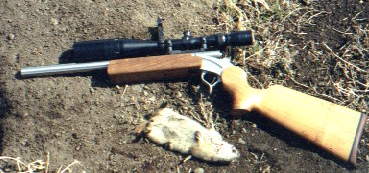
In the next 2 ½ days I shot over 100 squirrels with the Bullberry Encore over 200 yards. My
longest confirmed hit was at 450 yards. I shot 20 or so at 100-200 yards but it was so automatic that I saved
my remaining rounds for the longer ranges.
My CZ 527 really impressed me. I've never really worked with it except a couple of load work ups at the range.
The 12. gr.'s of H-110 and the 35 gr. Vmax make a deadly 3,100 fps combo. No ear muffs are needed and you can
hear the unmistakable whack when the squirrel gets hit. I found a squirrel sitting next to my 250 yard marker
and hit it dead center with the hornet. I shot over 100 squirrels with the CZ and smiled every shot. It is
really a great feeling to have so much confidence when shooting that you actually know you're going to hit
what you aim at.
My 223 Howa and my custom .17 Rem were, as usual, very deadly and got about 50 squirrels each. I didn't shoot
them as much as I should have but I was having too much fun with the Bullberry and the CZ.
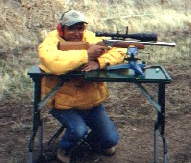
The total squirrels shot was over 320 for the 3 days. Not too bad considering the weather
and the eagles and hawks kept the fields quiet on and off during the day.
My rancher wants me to come back up after the 1st cuttings in June. He says the shooting action is the best
then.
Ok, I've been back for a day, give me a couple of days to reload, and I'm ready to go again, somewhere,
anywhere, point the way AL.
Bob in Antioch
GROUND SQUIRREL HUNT.... A better title, might be "FEEDING THE BIRDS". In the spring of 2000 three of us went to Northern California, near near the Oregon border to help the farmers with their ground squirrel problem (the locals call them "squeaks" because of the high pitched squeak they make). It was going to be a one day drive north, three days of shooting and one day to drive home. It was a good time, but cut it short by a day because of the heavy rains. Here are a few pictures of the trip.
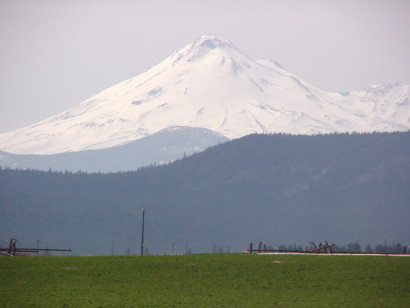
Fourty or more miles in the distance is Mount Shasta and here it is with an 8x zoom from my digital camera. Earlier in the day it was clear and by the time I thought to take a picture, the clouds had started to move in.
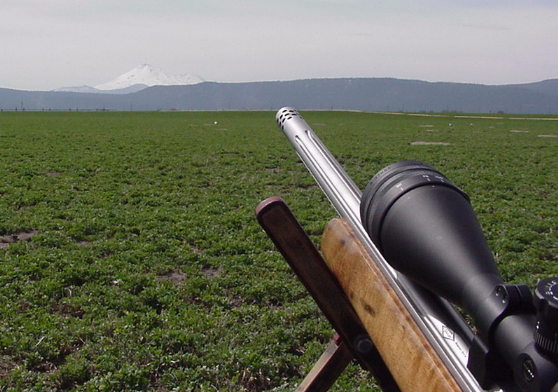
There was a delay in the activity. Often the squeaks will all go down at once and stay down for 30 minute or so. Then they will all start to surface again. Here is a shooter's view of one alfalfa field. Looking over the barrel of my Encore 223 Ackley Improved, you can see the sage rat mounds as brown streaks out in the alfalfa field. The three white specks are sea gulls feeding on squeaks. With the distant Mount Shasta as a landmark, it is a beautiful area except when it is raining. It rained on us the next to the last day or the shoot and we had to leave a day early. There was a lot of heavy rain on the long drive south. (No! I am not sighting on a Rock Chuck setting on Mt Shasta.)
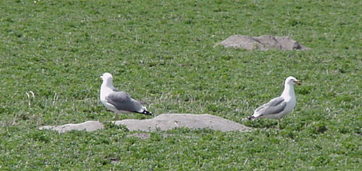
Nothing goes to waste. The sea gulls arrive after the first few shots are heard. They eat the intestines and leave the body. The eagles and hawks then move in and eat the rest. When the sea gulls are swooping around it tends to put the sage rats down for a while, but if the sun is out, they will eventually come back up even with the birds flying around. When the hawks and eagles arrive, the sea gulls move off a ways and wait for new hits.
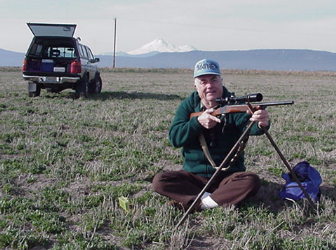
Here is Dick with his 223 Ruger #1V. He was making empties of the 55 gr Rem bulk bullets so he could start loading the more spectacular 40 gr Ballistic Tips. He is also thinking of getting a new barrel on the Ruger. The first field we shot was not the best. There was bunch grass the hid the squirrels and the field had been thinned out quite a bit before we arrived.
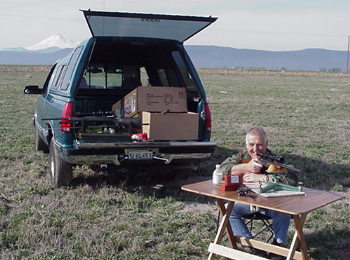
Here is Jack with his shooting bench. He was shooting mostly the 33 gr. .224 Hornady V-Max bullets and doing a good job feeding the gulls.
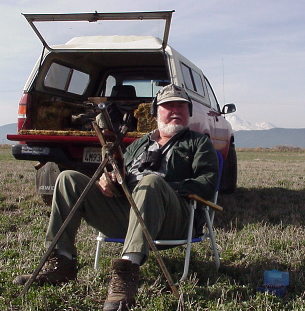
Here I am in my setup. A short chair and my Bi-Fur-Pod sticks. I had the camera on a timer and I just made it back to the chair before the camera clicked the picture. There was some fast action preceding this photo. It does not show very well, but I have my 17 Ackley Hornet resting in the Bi-Fur-Pod. The 20 .172 Hornady V-Max moly at 3773 fps were doing a spectacular job on "oiling the squeaks".
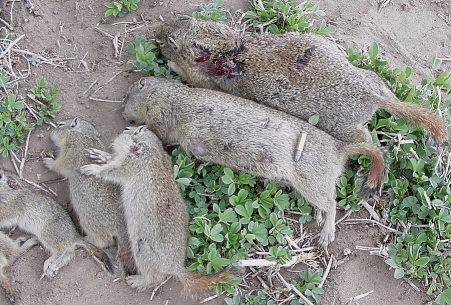
Here are some of the ground squirrels, "sage rats", or "squeaks" as the locals call them. I had to use a 22LR to "oil" these squeaks so that they would be photogenic. They are not as large as California ground squirrels. The 22LR round is in the picture to get an idea of the size. There are two full grown adults and 3 young squeaks in the photo. In some of the fields, one can set in one spot and shoot 200 to 300 of them in a 90 degree sector out to about 250 yards of so with out moving. Once the alfalfa gets to be 6" tall, you can't see the squeaks anymore. Our contact is going to notify us when the first hay cutting is made so we can thin them out some more.
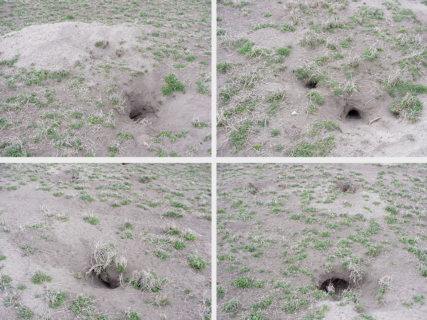
This is why the alfalfa farmers welcome shooters. The squeaks do serious damage to the alfalfa fields. Each group of holes will destroy a 200 square foot of alfalfa. Then when it is time to mow the alfalfa, the mounds damage the sickle blades and cost the farmers down time and expensive repairs. Below I have tabulated the rounds fired. The confirmed hits were actually seen through the rifle scope. On a couple of occasions, I did not see the hit, but later saw a sea gull swoop down and pick up the dead squeak. Keeping records in the field was relative easy. I merely put the case back in the box neck down if it was a miss and neck up if it was a hit. On the 22 LR rounds, I did not keep accurate records and am merely guessing at the results.
| Rifle Caliber | Total Rounds | Confirmed Hits | Misses | Percent Hits |
| Contender 17 Ackley Hornet | 124 | 97 | 27 | 78% |
| Contender 17 Mach IV | 42 | 28 | 14 | 67% |
| Encore 223 Ackley Improved | 63 | 52 | 11 | 83% |
| Contender 22 Long Rifle | 100 | 50 | 50 | ~50% |
| Total for Trip | 329 | 227 | 102 | 69% |
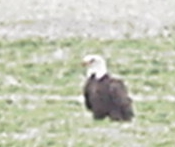
Shooting squeaks is merely feeding the Bald Eagles. When the eagles swoop in to dine the sea gulls give way. This eagle was at about 120 yards and I tried a 16X zoom with my Sony digital camera. This fuzzy picture is the best I could do at that distance. We must have seen 10 to 15 Bald Eagles, ten different species of hawks and thousands of sea gulls fly in to dine.
Stop & Drop
Calling & Fishing Trip
July 10-13, 2000
HOPE VALLEY.... Without all the bull you get in magazine articles about sunrises, big breakfasts, and the ride up HW-88, I arrived at Hope Valley and the West Carson River in the early afternoon on a solo Stop & Drop calling and fishing trip. The water was low and in the middle of the upper meadow I was scratching for fish. I caught one brown on a black humpy dry fly and got a couple of other rises. It was really rather poor fishing. I went to the lower meadow and gave it a try. The biting flies had made quick work of my bare legs while I was wading in tennis shoes. Here, I just wore my pants and let the pant legs get wet. What a difference downstream. A little more water, because of the additional tributaries, and the deeper cut banks, were good fishing. Using the same black humpy, I got 4 more nice brown trout up to about 10" inches long. These are not bragging fish, but they tasted very good. The five trout made a fine high protein evening meal. I went up on the western slope of Hawkins Peak and made the first "Drop & Stop" camp. No tent, no camp fire, just a little Bluet stove for cooking fish and a small tarp to keep the dirt off the bottom of my pad and sleeping bag. I made one stand and called for coyotes just about sundown, but no responses. The area was rather brushy and visibility was poor, so I could have been spotted before I saw fur. I could hit the packet network from camp.

Hawkins Peak with Red Lake in the foreground
Hope Valley is midway between the lake and Hawkins Peak but is not visible in this picture.
About 32 years ago, I climbed to the top of Hawkins Peak just to see what was up there.
EAST CARSON RIVER.... Day two, I drove through Markleeville, on HW-4, and asked about fishing the East Carson River. The limit is ZERO downstream from Hangman's Bridge and I had no idea where that was and no fishing above Carson Falls, and again no idea of the location. Well it turns out the East Carson River 1 mile upstream from Markleeville on up into the high country was open and the limit was 5 fish. Nowadays, one has to almost be a lawyer to figure out the fishing regulations. I also found out that the Wolf Creek that is closed to fishing is NOT the Wolf Creek that is a tributary to the East Carson River. While I was at the store getting directions, I asked if they had any Muciline (dry fly grease that used to come in a red metal can). No luck, it must not be made anymore. But they had some really good looking Royal Wolff dry flies. They have good stiff white wings, that I can see with my old eyes, and they float like a cork. I usually only fish with my own hand tied flies, but decided to splurge and bought 2 #12's and 2 #14's. It was a good move. Upstream to the West Carson River and I stopped at every good looking hole. The water was still pretty high and only pocket water looked productive. After about 5 or 6 stops, I found one place that I could get a decent float on a dry fly and got a nice rainbow about a foot long. That was a good start but not good fishing.
WOLF CREEK.... I finally left the East Carson and headed up to Wolf Creek. I met one of the ranch hands coming down the road in a back-hoe with his cowboy hat and asked him if there was a coyote problems and gave him one of my cards. He said there were a few coyotes, but not that big a problem for the cattle, however sheep were a different story. He said it was OK to call on the other side of the meadow and also said it was OK to fish in the meadow, so fishing I went. Using one of the #14 Royal Wolff's, it was story book fishing. Almost every hole had a good fish and they were eager to take the dry fly. I caught and released a number of fish and kept a rainbow and 3 brook trout in about 30 minutes. There were a few coyote tracks in the mud of the creek. I stopped at the upper end of the meadow where there was a campground and cooked the fish for the afternoon meal. Very tasty but the brook trout always taste the best. Well, enough fishing for the day. I checked out the area for a possible coyote calling location and the only good looking spot had a No Trespassing sign, so I decided on skipping the coyote calling even with the verbal permission.

Up near Monitor Pass
At least one coyote is still here.
MONITOR PASS COYOTE.... I drove up HW-98 near Monitor Pass and took a 4WD road up to a mountain top. There was a nice little camping area under the scrub oaks for the evening. After getting everything ready for the evening and about an hour before sunset, it was time for some coyote calling using the Circe Cottontail call. I went east from camp about 1/4 mile and called the area shown in the picture. About 10 minutes into the call and the cottontail was really hurting, here comes a coyote through the sagebrush. He was about 300 yards out when I first saw him. I tapered off on the call. No use calling while he is inbound. On the way in, he went behind the only little tree in front of me and I lost sight of him at about 250 yards. After what seemed a long time and no coyote, I switched to the squeaker call and saw the coyote again through the left edge of the tree at 200 yards. He was setting and looking right at me. I tried easing a few inches to the left for a shot and it spooked him. He headed back toward the brushy hill. He was going slow and zigzagging thought the sagebrush. I tried a desperation shot and missed. That coyote really turned on the afterburners and flew over the sagebrush and out of sight behind the hill. I tried one calling at one more spot before dark with no success.
COMMUNICATIONS HOME.... I have a 2m Ham radio in the truck and have it hooked up so I can operate portable Packet Radio. I have an old Toshiba T1000 I got for $10 that needed a new set of batteries that cost $36 plus a Kantronics KPC-3. That is all it takes to operate portable Packet from remote locations. I was able to hit the YRGTN network node from every campsite I chose on the trip. Camp high, fish low, and call coyotes from everywhere. Going from the YRGTN node to the WALACE node to DELTA and I could send and receive packet messages from my wife, Mary Ann, WA6QPU (now upgraded to General Class), Jack, K6JAC and Randy, KD6PLI. It is fun to be able to make contact when you are out in the wilds. It is comforting to know that everything at home is OK and that Bart was doing very well on his Retrieving Lessons.
MORE CALLING ON MONITOR PASS.... Next morning I did some more coyote calling near my camp in the Monitor Pass area. I went West of camp and gave it a try. After about 15 minutes, the only critter I saw was a big old marmot. All I could see was his head above the rock. Well, after another five minutes, I decided to take revenge on "Son of Blueberry Cobbler". About 10 years ago, Mary Ann and I were on a 22 day backpacking trip up in the High Sierras. On about day 20, with very little food left and at Sky Blue Lake, Mary Ann fixed our next to last "Good Meal" which was a blueberry cobbler. She mixed the water in and set it near camp in the shade with a big rock on top to protect it from the critters. Well, when we got back from fishing, a big fat blue-faced marmot had eaten every bit the blueberry cobbler. I ran him off, but now a chance for revenge. At the crack of my old Sako 243 Win and the 95 gr Nosler Ballistic Tip, I head the splat. Then when I recover the sight picture, I saw the decapitated body of the marmot roll off the rock.
BEAR FACTS.... Next, I moved to another good calling locating above a grove of Quaking Aspens and setup. Again with the Circe Cottontail call, I gave out a series of screams for about 1 minute and then about 1 minute of quiet. After about the fifth series I see a ground squirrel setting on a rock, but no coyotes. The ground squirrel makes a very good sentry. If anything approaches, the ground squirrel will see it. A couple more series and the ground squirrel takes a dive. I get ready and here comes a big brown bear! He was coming straight in at about 150 yards. I quit calling and the bear keeps walking in. At about 100 yards, I begin to get nervous, so I take a shot at a rock about 15 feet off to the side of the bear. Bang-splat and the bear doesn't pay any attention. I stood up at port arms and growled at the bear. The bear stops and then slowly starts walking toward me. I don't want anything to do with the bear, so I take another shot at a rock about 6 feet to the side of the bear. The bear stops and goes over and just sniff where the bullet hit. I growl as loudly and as fiercely as I can and finally the bear stops at maybe 80-90 yards. I only have only 2 rounds left in the magazine and more ammo, but it is tucked away in my fanny pack in a bullet wallet. I am thinking about how long it would take to reload. Then the bear turns to the side and slowly walks into the Aspen grove. I take a big sigh of relief and end my coyote calling for the morning.
TOWN OF WALKER & WEST WALKER RIVER.... Over Monitor Pass and down the other side. There is the beautiful area called Antelope Valley. The DF&F has taken it over for a winter habitat refuge for deer with no public access and also the tiny creek that runs into it is closed to fishing until Oct 1 and the limit is zero. Our tax dollars are being used to keep us from our own public lands with every possible excuse. There are too many PhD graduates that now have jobs experimenting with the environment like little tin gods Their mission in life appears to be keeping people out of wilds. They want to preserve their environmentalist's private and exclusive playgrounds. My politics are showing. I stopped in the town of Walker on HW-395 and looked at our 1 acre of land right on the West Walker River with 88' for water frontage. Two years ago, there was a flood and it washed right through our land. It must have ruined a lot of property from the looks of our lot. We kept it too long. Anyhow the West Walker River, at the town of Walker and upstream for about 10 miles, is now a sterile rock walled channel that looks like the LA River. There is no good trout holding water, just raging current in the EPA approved channel. It used to be good fishing, but not anymore. It also looks like the town of Walker is dieing on the vine too.

West Walker River for 15 miles is a sterile channel and looks like the LA River less the "LA Brown
Trout" floaters and sinkers.
UPSTREAM ON THE WEST WALKER.... I went upstream on the West Walker River to past the Marine Winter Training Camp on HW-108 and to the head of Pickle Meadow. Pickle Meadow is now some kind of a trout preserve and all fenced in, but reading the regulations, it is still open to fishing with a 5 fish limit. There is foot access only and I walked into the meadow to try my luck (skill). The water was just about right. Where the Poore Lake Creek joins the River, there was one hole with cutthroat trout. I caught and released 3 of them that were about 8" long. They were very slender and the cutthroat red markings were quite pale, but definitely there. I proceeded upstream from there and found one good holding pool at the tail of a long run. The first cast with the Royal Wolff and I got a hit from a large rainbow. I missed him, but he felt the hook. I figured that was going to be all. Well, a few casts later and I got a good rainbow on. It was quite a good fight with a number of time where he broke water with nice jumps. Then he took me downstream in the current, but I finally got him in. It was a planted fish, but from his stamina, he mush have been holding in the river for quite a while. All of his fins were completer with white tips and no hatchery wear. I switched to an ostrich quill nymph and caught two more nice rainbows a bit smaller from the same location and that was plenty for dinner. There were no good places for calling coyotes in that area. I did talk to 3 cowboys fixing the irrigation ditches on Silver Creek and gave them my Coyote Hunting "Business Card", but there was no real interest in my services. The Fish Sniffer has a good report on the West Walker River.
NEVADA & RISUE CANYON.... I went back through Walker for fuel, beer, and ice and then on to Nevada. About 20 years ago, we hunted mule deer in Nevada in Zone 201 and Risue Canyon is right in the middle of the zone. The regulations in Nevada state that if you have a valid hunting license in another state, you can hunt coyotes in Nevada. I wanted to see the old deer hunting area for old times sake. Without a map, I found the old hunting camp area and took a picture of the grove of scrub oak and bushes where I took a deer on the hunt so many years ago. It was 11°F and blowing snow. When I finally decided to take the spike (legal deer at that time) I had to dig my rifle out of the snow. Anyhow, I digress. I went right up to the crest and tried calling with no success. Then over to the next drainage and still no success. I didn't even see any coyote tracks. Well, I went back to the old camp site and walked over a rise and setup. With the trusty Circe Cottontail call I started the rabbit screams. After about 5 minutes of calling I see a young coyote setting and looking at me across the canyon at about 250 yards. He was obviously not going to come any closer so I opted for the shot. I cranked the power on the Tasco up to 16X, adjusted the focus, and dialed in 250 yards. I had all the time in the world. There was a bit of cross wind blowing down the canyon from the right, so I guessed about 6" of holding into the wind and touched it off. I am not sure on the hit. It is a possible. I continue calling. Young coyotes are stupid and sure enough, up pops another coyote at about 225 yards. It is another setting shot. I dial 225 yards and still about 6" of wind and take the shot. It was a good hit and I see the coyote on the ground.
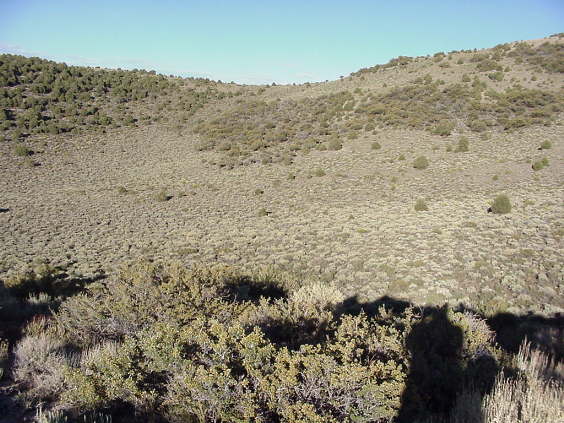
This is the excellent brushy grove where I got a Mule Deer about 20 years ago.
Beauty is in the eye of the beholder, isn't it?
BEAR FACTS AGAIN.... I am still calling for a possible third coyote and here comes a brown bear. Two bears in one day! Well, the bear is about 200 yards out coming my direction and I quit calling. I have just fired twice, and again only two rounds left in the rifle, but I am not so nervous because there is a canyon between us. I am watching and the bear turns and starts walking along the far hillside away from me. He continues on a couple hundred yards and then I lose sight of him in the pinion pine trees. I wanted to go over and look for the coyotes, but first I reloaded, one in the chamber and three in the magazine. The cover was pretty thick over there among the pine trees. I found the second coyote easily enough and looked for the first for quite a while as I kept checking around for the bear. I have to admit I didn't look as hard as I normally do for a possibly downed coyote. I didn't find it and finally gave up on the search. This calling took place about 1/4 mile inside of Nevada from the California/Nevada state line. I moved uphill to a good camp location where I could hit the YRGTN packet node. There are yellow painted posts that mark the boundary so I slept in Nevada that night about 50 feet from the state line. While I was on packet radio, a big bull came up the road and wanted to get by. He was brown and at first, I thought I was having another bear problem. Getting jumpy I guess. It got dark on me and instead of cooking the fish, I had my standard meal of cookies, power bar, and light beer. I had the 357 by the sleeping bag on one side and the Rush (rerun on KFBK-1530) on the AM at the other side. I fell asleep before I heard much of the Rush program.
LAST DAY.... Up bright and early and calling coyotes in Nevada, I made five stands in the Risue Canyon and did not see hide nor hair. At one spring, there were some old tracks, but that is all. It was getting very hot and my last soda pop was gone. I hung it up and headed back for Monitor Pass and the nice little camp where I cooked the three rainbow trout. They were not as good as the native fish, but were still very good. I was going to give the West Carson River one more try and camp again on Hawkins Peak. When I got to the West Walker there was a very strong wind. There were two guy out fishing where I stopped. One was fishing down stream and would be bye before I could get to the stream. I always fish upstream with a dry fly so I get a good float. The other guy was quite a ways upstream standing up on top of the cut banks and fishing down also. There was about 300+ yards between them and I headed for that area. I never saw the guy downstream once I got to the water. I fished one cut bank and the guy coming downstream quit about 200 yards out. I feel a little guilty, but not too much. I proceeded upstream to where he was standing, but wading in the water to stay low. In a hurricane force wind I forced the #14 Royal Wolff next to the cut bank for a good drift. It took a lot of power with the #4 weight double taper line and 12' leader, but it worked. About halfway down the edge of the cut bank, a large rainbow took the fly. Set the hook and the fight was on. It took quite a while to get him in to where I could lift him out. Here was a good fish for taking home so Mary Ann could taste trout. I had to cut him in two pieces just to get him in my vest pocket. I took him up to the ice chest and went back and got 2 browns and a rainbow. It was a good trip and I got to see all the old country. Years ago, I took one summer vacation of only Fridays. Every weekend was a 3 day weekend for fishing in High Sierras and I had a very good time and learned the country.
TWO WEEKS LATER.... I took another fishing trip into the same country. It was also a good trip. and this time I took more pictures. This was also a "Stop & Drop" camping trip. It takes me only 5 minutes to get ready to cook my five trout for lunch. The food-box, cook-box and ice-chest make a good wind screen for my little stove. I had no success calling coyotes, but did do quite well with the fishing. Dry flies were very effective in each of the streams I tried and the Royal Wolff was the best.

This is the meaning of "Stop & Drop" Camping.
Five minutes and I am ready to cook a mess of trout for lunch.
Ten minutes after lunch, I have the truck packed and I am portable again
and ready to head to the next location to call a coyote of fish another stream.
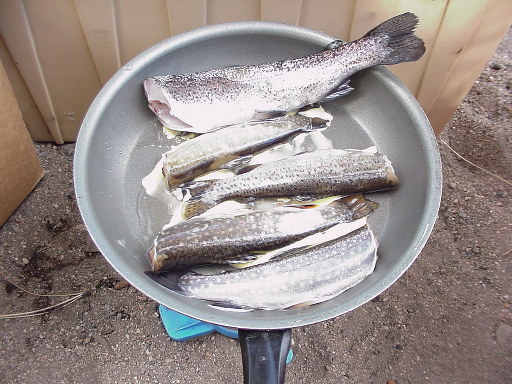
Three brooks and two rainbow make a very tasty and fine lunch.
I am getting ready to cook. After the picture, I sprinkled a little Complete Pancake mix on them and started
cooking.
A Varmint Al two course meal: Trout and Beer.
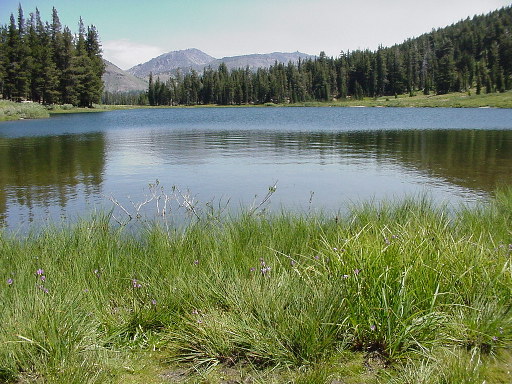
This is the West most Highland lake off HW-4 and up a rough dirt road. It is beautiful.
I got some good flower pictures, but I won't bore you with them here.
I tried the spinning pole here and did not get a single strike.
There are fish in it because I saw a number of rises. Win some lose some.
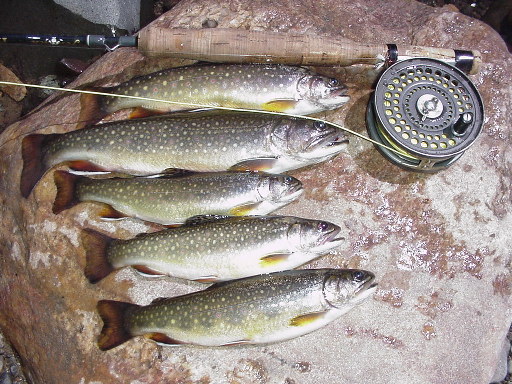
Here are five nice brook trout. It took only 30 minutes to get these on a #12 Royal Wolff dry fly.
You can see the beat up fly on the real seat.
They were rising very well to the fly.
The water was very low, but that didn't put them off the rise.
The Fish Sniffer The #1 Newspaper in the West
Dedicated to Fisherman.![]()
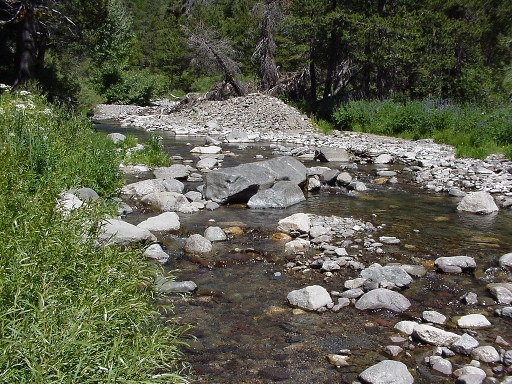
Here is the stream where I caught the brooks.
There were one or two fish in every pool of any size.
There were two in the pool just to the right of the big rock in the center of the picture.
It looks like most people pass up this stream thinking that the water is too low for good fishing.
Good hunting and fishing from Varmint Al
TROUT FISHING WITH BART.... Went trout fishing up in the Bridgeport area with Bart. It was late season in 2003 and the water levels were very low and just right for dry fly fishing. I had been taking Bart on our coyote hunting and fishing trips. Bart is very good at spotting coyotes and other critters that come to the call. I had been letting Bart trout fish with me. I usually fish upstream with a attractor type dry fly. Bart watches the fly and when I hook a fish he gets all excited. He jumps into the water and tries to chase the hooked trout. Usually the fish are pan sized and I can lift them out onto the bank and let Bart 'fetch' them to me.
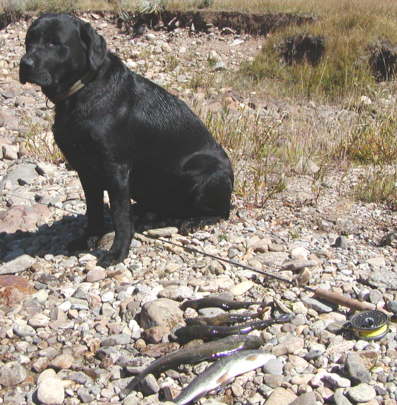
Well, on this fishing trip, I finally decided to let Bart actually fetch the fish out of the water. I was fishing the Little Walker River and all I had to do once a fish was hooked was to play it for a short time. Bart would chase it, but as long as it was below the surface, he couldn't keep track of it. So as soon as the trout became tired enough so I could bring it up to the surface, I would just hold it there. Bart would see it and go over and grab it. He would get a good hold and head for the bank. About 10 feet from the shore, I would join him and have him deliver the trout to hand. This really works well and is a lot easier than a landing net. When you have a Labrador Retriever, they want to retrieve and it doesn't matter much what it is. For more info on Bart, click here to view his web page.
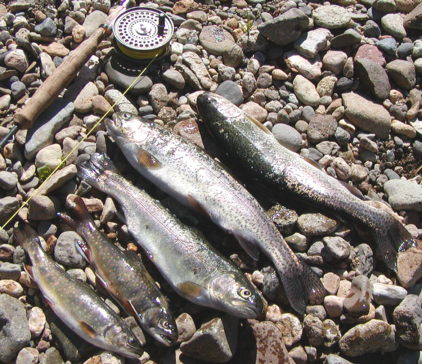
Some evidence of fetching on the middle fish.
But not too many fetch marks!
COYOTE CALLING WITH A LABRADOR RETRIEVER.... I use Bart as a coyote calling dog. While calling, he is on a very short leash tied to my belt. The leash is so that he can't bolt and get in front of the rifle's muzzle. He sits beside me watching, sniffing, and listening. He often sees the incoming coyotes before I do and when they are coming in from upwind, he smells them and lets me know with a very quiet growl. Bart has very good eyesight and can see distant movement before I can. Bart is very alert when we are calling just like he is when we are dove or duck hunting. Happiness is an all-purpose Labrador Hunting Dog! Click here for the complete story of the hunt up in the Sweetwater Mtns.
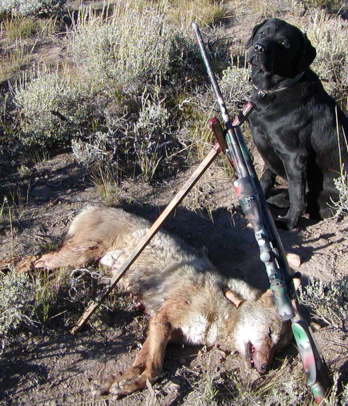
This Old House
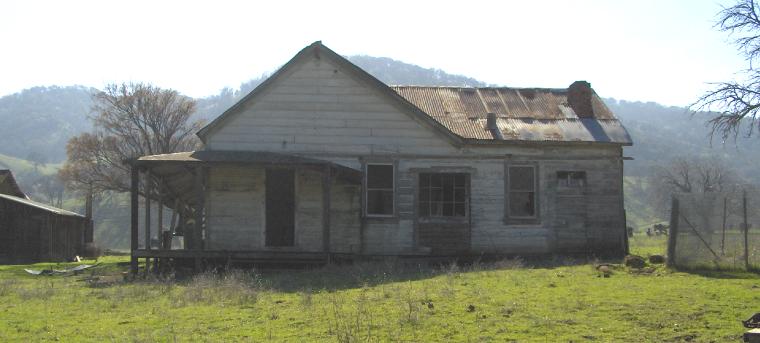
One of the areas where I have hunting access has this old house. It is about
gone, but must hold many fond memories of days gone by. I was hunting coyotes,
but decided to take some pictures before it goes away.
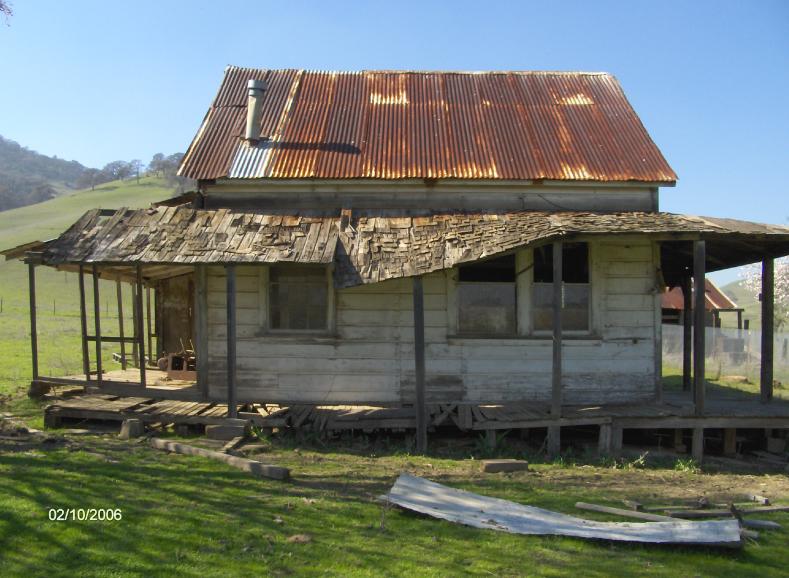
The old tin roof looks like it holds out most of the rain, but the awnings are
not in very good shape.

Inside the living room, there is a cozy fireplace, a couple of easy chairs and a
book shelf. There was no evidence of electrical wiring and the power poles stop
a few miles away from the old house. The paper plate on the wall is a note from
Art's sister.
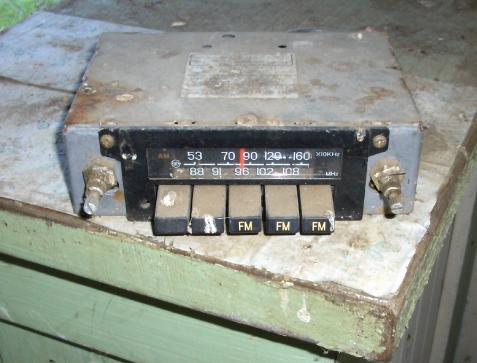
An old car radio must have been the entertainment center when Art's eyes got
tired of reading. This looks like one of the old radios that had a vibrator to
generate high voltage for the tubes. It must have been tough on his batteries.
The good old days.
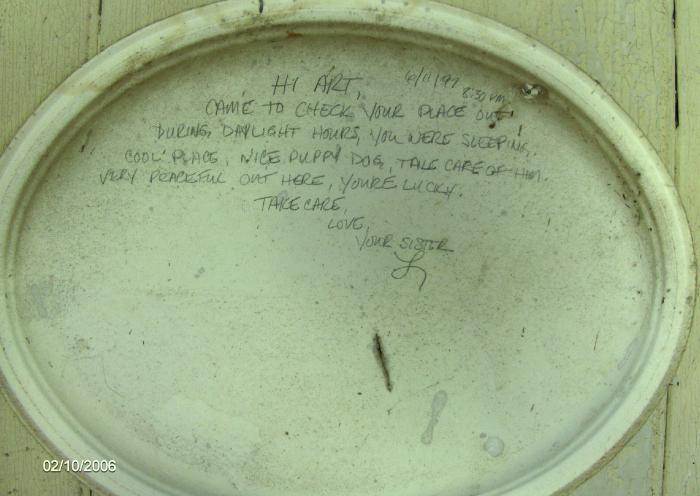
The note reads:
Hi Art, 6/11/97 8:30 PM
Came to check your place out
during daylight hours. You were sleeping.
Cool place. Nice puppy dog. Take care of him.
Very peaceful out here. You're lucky.
Take Care.
Love
Your Sister
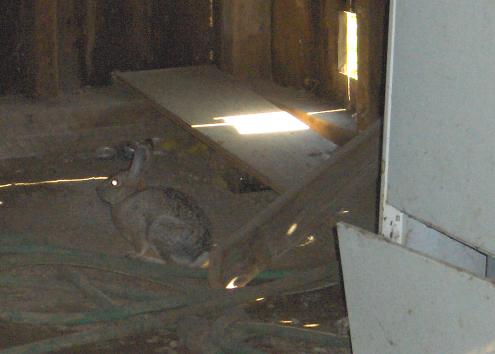
In one of the out buildings, the current occupant is a cottontail. He let me get
pretty close but finally dove under the board when I tried to get a close-up.
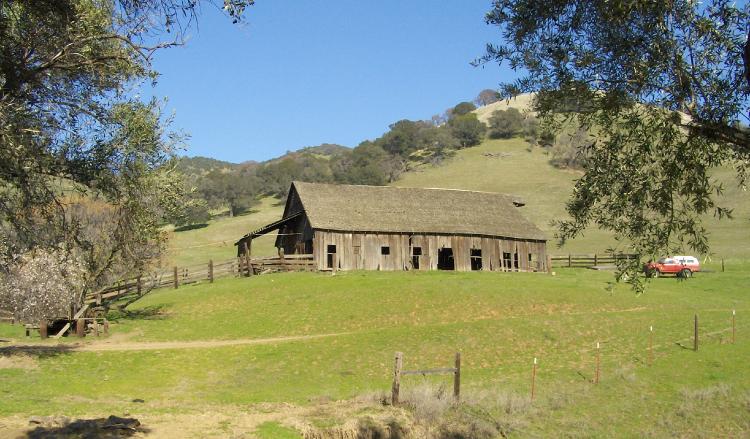
Here is the old barn. Cows have free run of the place and, in the past, I have
called in 3 coyotes in this area.
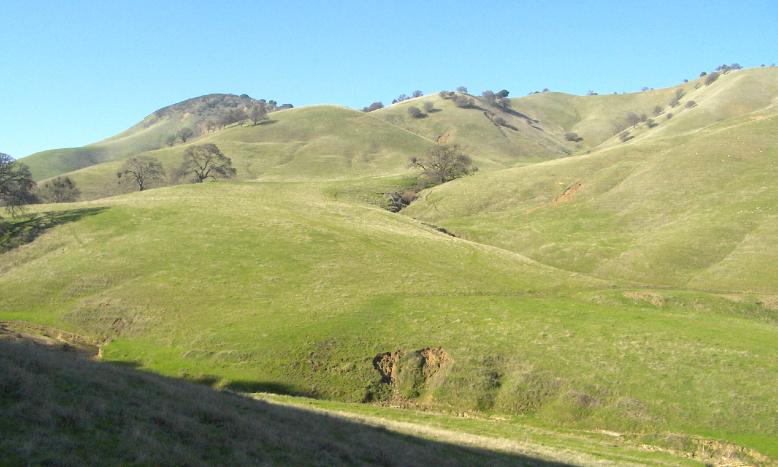
This is looking North West and even though it is February, it feels like the
middle of spring here in California.
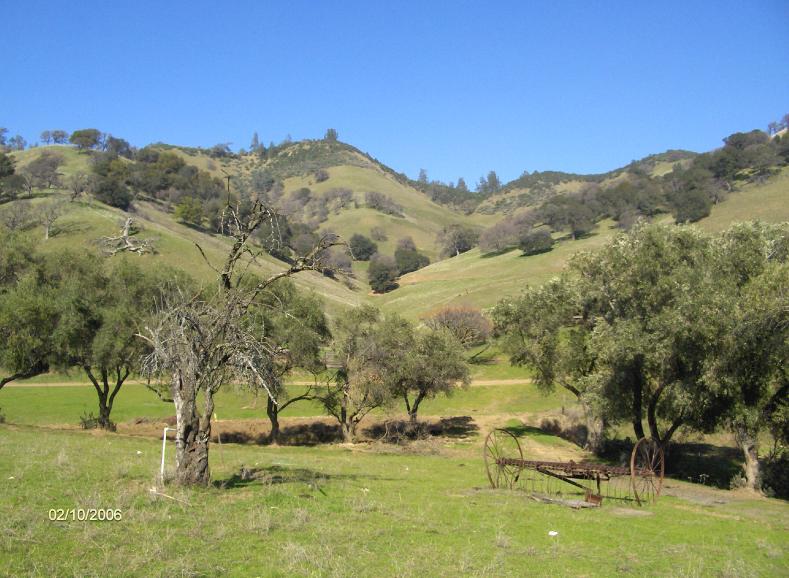
I called up this draw with no success. One calf was very interested in the
sounds, but no coyotes. The last rain was about 2 weeks ago and the ground is
hard. I saw no coyote tracks, but they would be very difficult to spot in the
hard ground marked by many cattle hoof marks.
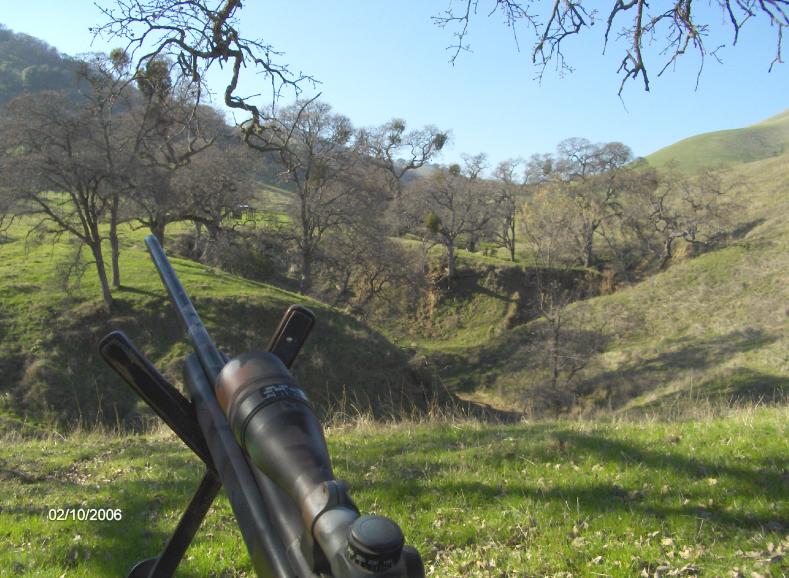
I was trying out some of my sound files with a home made MP3 player, Radio Shack
Amp and a horn speaker. From a distance, they sound pretty good. I especially like
the sounds of the dthowl2.mp3 file and the group2.mp3 file. Good sounds, but still no
coyotes. Here is the second stand. The is up the draw to the west. There is an old
windmill just to the left and I have called in a couple of coyotes to this spot,
but not today. It was just fun to be alive and out in the middle of winter. Life
is good.
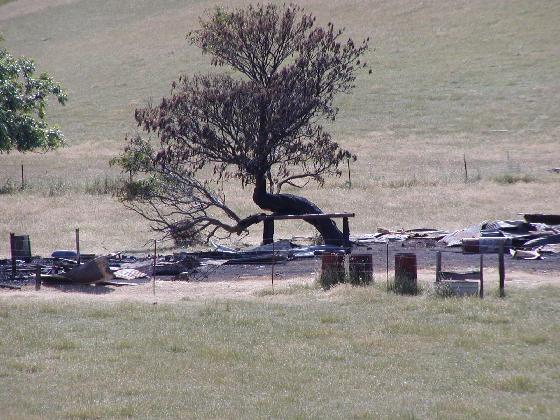
THE OLD HOUSE IS GONE.... Three months later I came back coyote hunting
and the old house had burnt down. Too bad. A lot of memories were lost but at
least there is a small tribute to it here on these pages. I made a Old
House Tribute Page of all the pictures I took of it before the fire. This is
not meant for dial-up viewers. The pictures are large.
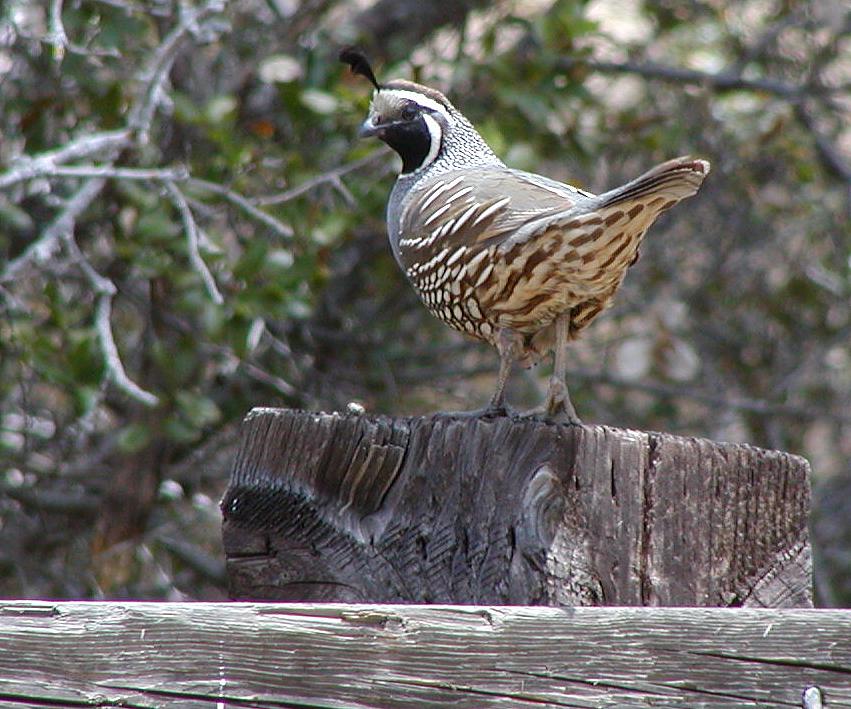
I got skunked on a coyote hunt, but was able to take a couple of good California
Valley Quail pictures. I was able to get about 10' away from this rooster and
used a 10X optical zoom.
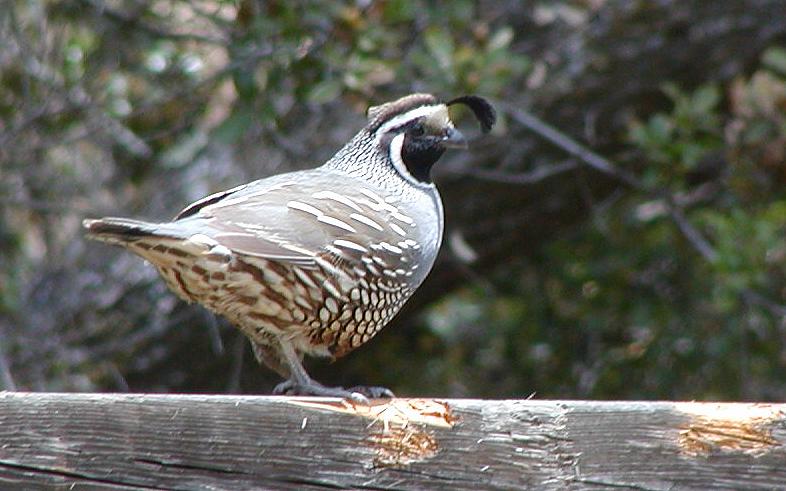
Here is another view. This was the top rail of a corral about 3 miles from Mt
Diablo, CA.
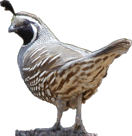
After fiddling around with image software for an hour, I was able to make a
pretty good transparent .gif file of the quail.
MY BEST SHOT by Varmint Al.... This is kind of gory, but here is the story. I was up at my mountain cabin and there was a cow laying down at about 600 yards across the canyon on the far hillside which is very steep. There was a calf besides her and after a couple of hours, I could tell something was wrong. I don't know who the cow belonged to, but she was on my land and I decided to take a look. When I got to her, she couldn't get up. I tried to force her up, but she couldn't get her hind legs under her body. I tried pulling her around so it would be easier. I kicked some holes in the ground so her hind legs could get some purchase. I even twisted her ear to see if that would make her get up, but nothing worked.
The next morning the cow and calf was still there. I looked at her through binoculars and her ass end was red. I took my 243 and went over to investigate. The coyotes had eaten a hole out of the cow's rear end the size of a basketball! Her eyes were rolling and her ears were flopping and it was gruesome. I put her out of with one shot in the top of her neck. I wanted it to be a shot angle that would be impossible for someone to make on a standing cow.
![]() The next morning before dawn, I was sitting on the
"firing line" (a place where we shoot clay targets from on the far hillside) and waiting for the
coyotes to come back to the dead cow. Just after daylight, here comes a coyote and it goes around to the rear
end of the cow and starts to feed at the gaping hole. The distance was 400 yards and I cranked in 400 yards on
the Tasco TR scope, set up my shooting sticks and started to squeeze one off. Just as I pulled the trigger,
the piece of meat the coyote was pulling on, broke lose and the coyote moved backwards and the bullet hit in
front of it.
The next morning before dawn, I was sitting on the
"firing line" (a place where we shoot clay targets from on the far hillside) and waiting for the
coyotes to come back to the dead cow. Just after daylight, here comes a coyote and it goes around to the rear
end of the cow and starts to feed at the gaping hole. The distance was 400 yards and I cranked in 400 yards on
the Tasco TR scope, set up my shooting sticks and started to squeeze one off. Just as I pulled the trigger,
the piece of meat the coyote was pulling on, broke lose and the coyote moved backwards and the bullet hit in
front of it.
The coyote turned and with full afterburner started running to my right. It went behind one tree and when it cleared the tree, I lead it about 6 feet and broke its back. I looked up and there was a second coyote running straight up the hill. That one was at about 500 yards and I lead it about 10 feet and broke its back too. I don't shoot that well at running shots. It must have been determination. I walked over and finish off both coyotes. This whole episode really confirmed my interest in hunting coyotes. I have never attempted shots like that since. Footnote: I sent the Sako action in for a new Shilen stainless steel barrel right after that, because the old one had over 10,000 rounds through it and was shot out!!
MY HUNTING WALL.... Here are some pictures of my Hunting Wall. I have not had the urge to try for trophy animals, but who knows? I am sorry about the quality of the photography. It was the best I could do with my old 35mm camera that has no flash. Maybe I can do a better job some day with the video camera and a Snappy.
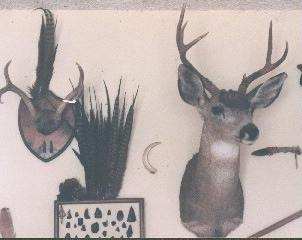
I took this 3x2 Blacktail Buck on a solo hunt up at my
mountain cabin. I was using a Rem Model 7 in 243 Win and the 100 gr. Sierra Game King spitzer bullet. It is
the only deer that I have ever had mounted. The 7" tusk is from the 250 pound wild boar that I also got
up at my cabin. The story of the pig hunt is below. I like to hunt pheasants every season and I save the tail
feathers for fly tying. The 2x2 Blacktail was taken with a 17 Rem at 300 yards with a 25 gr. Hornady HP. I
carefully placed the bullet between 2 rib bones and severed the top of the buck's heart (good luck). He ran
about 30 feet and fell in a heap. I don't recommend the 17 for deer. It was a stupid thing to do using it, but
I was lucky that there were no bad consequences.
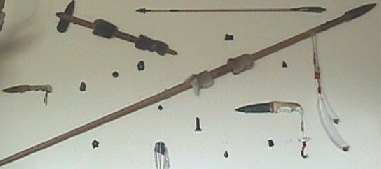
Since I am 1/8th Paiute, lots of Indian artifacts. Here are
some replicas of the tools of my ancestors. The spear, tomahawk, and knife were props used in the film
"Dances With Wolves". The points of these three are made to look like obsidian but are actually
black anodized aluminum. The arrow is a recent manufacture to early American standards.
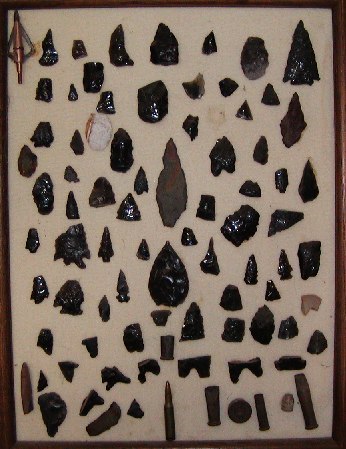
Here is sort of an historic page in the advancement of
hunting efficiency. The early points, to the modern broad head in the upper left corner to the rifle cartridge
(222 Rem pictured here) have all at times been effective at keeping the hunter and his family's bellies full.
Opening Day of Pheasant Season
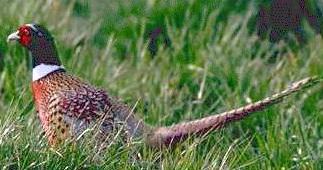
Phasianus colchicus
PHEASANT HUNTING.... Today (Nov 8, 1997) is the opening day of pheasant season here in California. Last night, I got out the old Winchester 101 20 Ga. OU with 30" F&F to get it ready. I broke it open and the distinctive click sounded when the ejectors attempted to throw a nonexistent empties over my shoulder. In the other room, Oscar my "sort-of" black lab went wild. When I pick up a rifle he pays no attention, but the shotgun is his alert to the pending season. He has a good memory. Oscar was following me around the house as I was getting my vest filled with shells and getting a new set of hip boots adjusted. He was sure excited. It is a good feeling to see the dog so happy to go hunting. (There is a picture of Oscar on the Bichon Frise II page.)
This morning we went out and Oscar was so excited, he tried to jump into the truck before I could drop the tailgate. I got my arm band on for identification and had to wait till the 8:00AM opening time. The dog doesn't understand why we wait around when the pheasant smells were floating in the air. When it was finally opening time, we started out and the first big patch of tall cover, we jumped about 30 hens. Hens were going every which way. After watching so many hens rise in every direction, my guard was down, and a big rooster got up off to the side and got too far before I could pull down on him. It happens that way sometimes. ;-) Well, after an hour of walking I got near some big blackberry bushes and I heard hunters on the other side. Here comes a big rooster over the top of the bushes, surprising me and I blow to holes in the air some where in the general direction of it. He was 30 yards high and really going, must have been on full throttle. Well, Oscar goes off running in the direction of the pheasant, having unjustified faith that I had hit it. No such luck. The other hunters are still there and finally jumped another big rooster Here he comes at about the same path and speed. I swung through this one, at about 40 yards, and tapped the trigger and it was a perfect hit. The bird folded without another wing flap and Oscar ran over to get it. Oscar doesn't retrieve, but he holds the bird until I get there. Never could teach him to retrieve, but he is a good hunting dogs in all other respects. One bird for dinner tonight and I am resting at the KBD waiting for the afternoon hunt. One more to go to fill today's limit. Opening day just makes you feel good to be alive. If you would like to read about pheasants habits click on Ringneck Pheasants In The Wild.
TOO FAST.... Wow, that was fast. The first day of pheasant season in 1998 and I limited out with two roosters in 12 minutes. It was foggy, but the visibility was about 250 yards at least. Oscar did a great job jumping the birds very close in. I have to admit that on both roosters, the first shot, just got them going the correct speed and then with the upper barrel, I was a little more careful and dumped each one. I always shoot the Under barrel first because it is more inline with the shoulder and there is a straighter recoil. I am shooting an old 20 Ga. Win 101 O&U with 30" F&F. I was using the all plastic Activ shells with 1 Oz of #4's. Oscar was sure happy to be out hunting again, but he didn't even get tired in 12 minutes.
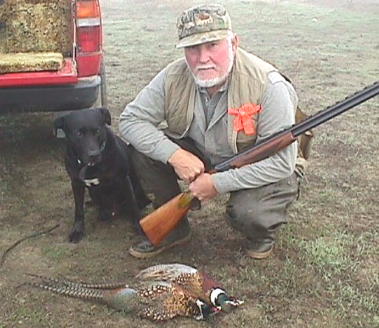
The two rooster are both young birds. They have short stubby spurs and will be nice and tender. Some of the
old roosters with the long sharp spurs cook up like rubber bands even after a four hours in the crock pot. We
will have pheasant for dinner tonight. I took the picture with the Sony digital camera and pruned it down with
WebRazor so it is pretty well compressed. Tomorrow is another day and I will be out there for two more birds.
Isn't hunting grand?
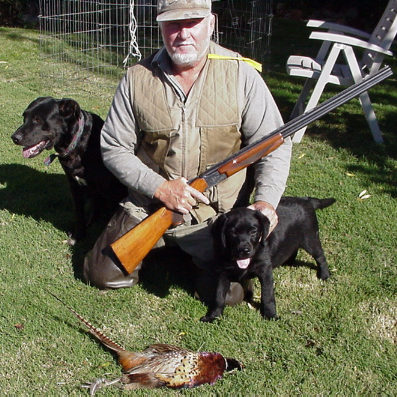
Pheasant season 1999 and I have a new Black Lab puppy named Bartholomew. Little Bart went on his first successful pheasant hunt today. I have to hold him or he would be over "fetching" the bird again. I wasn't able to watch Bart's reaction when he heard the shotgun report the first time, but he was right by my side when I was fishing the bird out of a berry bush. Oscar is not very excited about picture taking. We have 3 more weeks of pheasant season. Little Bart is getting his kindergarten course in pheasant hunting this year. I have started a page for Bartholomew with more pictures.
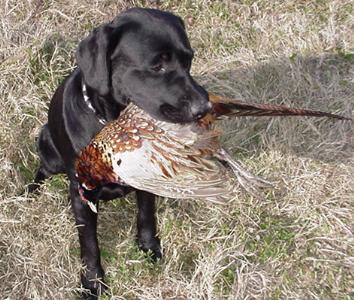
Here is Bart posing with a fine rooster on the second weekend of the Nov, 2000 season. He is becoming and excellent pheasant dog. Not many ducks down yet. The weather is not miserable enough yet for the ducks to move south.
Here is a Steelhead I got in Piper Slough. I used a WeeWart and this steelhead only jumped about 4 times. Often, when they jump, they shake out the lure, but as you can tell this guy couldn't shake it. Pheasants out the front door, ground squirrels on the levee, coyotes at the sheep ranch, and fish in Piper Slough. It is tough living on Bethel Island. I just wish it wasn't in California, but I guess I will have to suffer.
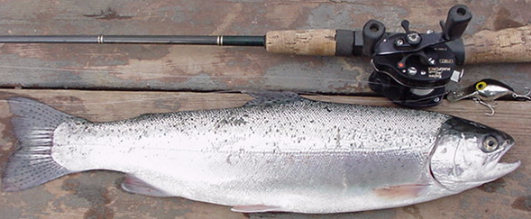
Two weeks later and another fish. I don't know how BIG this fish is, but it was so large, the original picture took almost a Mb of disk space and my Hard Drive is two pounds heaver just storing the picture.. ;-)
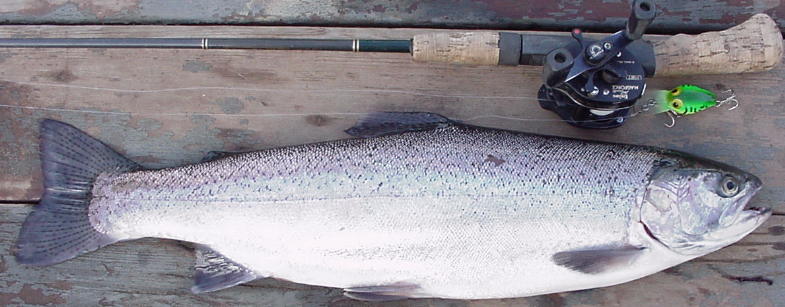
Calling Javelina
by Author AP Jones
www.javelinahunter.com
Calling Javelina
Let me first state, predator calling for Javelina should only be used in a situational manner (I'll explain
later). If used incorrectly or in the wrong situation, predator calls will prove worthless. In fact, it will
scare the Javelina herd away 99.9 percent of the time. Despite predator calling limitations, it's without a
doubt the most exciting way to hunt Javelina. Using a predator call exploits the Javelina's propensity to
counter attack predators and come to the aid wounded or distressed herd mates.
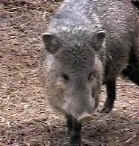 How
to use the predator call.
How
to use the predator call.
The first thing you need to do is purchase a predator call. There are many good choices for under $10, call's
that mimic or are advertised as "cotton tail" or "jack rabbit" distress calls work best
for Javelina hunting. Next, forget what you know, or think you know, or how you've used calls in the past.
Most hunters have "played around" with a call before. You blow into it, it sounds kind of like kazoo
or fairly deep "waaaa.... waaaa..." sound. To affectively call in Javelina you want to imitate the
sound of a piglet getting the hell chewed out of it. This is done by blowing violently, using your hands to
cup the end of the call to mimic the piglet's mouth opening and closing. Imagine what a frightened piglet
sounds like, adjust your hands and the "blow" pressure accordingly until you sound like an axe
murderer at a teenage slumber party.
Situational Use
Use a predator call only in three situations.
Situation number 1. You've spotted the herd, they are no more than 60 yards away and you can't easily
close the distance because of thick brush (to noisy) or it's to open of an area (no cover).
Before calling you should "set-up", pistol or bow at the ready, kneeling position, with the location
of all animals identified as best as possible. Your call should be on a lanyard, so you can spit it out of
your mouth after calling (hands on weapon), buts its quickly retrievable if needed. A 3-4 second calling
sequence will normally do the trick. As soon as the call sequence is complete be ready! Javelina will be
coming fast. Generally they make 15 to 20 yard charges, stop, and charge again towards the area of the call.
You will often hear the "woof" sound they make with each step they take, as there coming in. Stay
calm and pick a clean shot. Don't hurry the shot or settle for a bad shot, or worse yet "flock
shoot", and don't worry if they see you. I have called in, shot, and missed the same animal three
different times with a pistol before, and ultimately bagged him. It can go like this, shoot, miss, the animal
runs away, blow on the call, the animal comes back, shoot, miss and so on.
Situation number 2. Your humping along (day dreaming) and bang, off busts a herd at 40 yards in 5
different directions. Get on the call (blow) immediately. 3 to 4 seconds, look for animals and listen for
"woofing", wait a few seconds and back on the call for another 3 to 4 seconds. Generally, not all
the herd will of seen you. Some Javelina may have stayed "frozen" unsure of the exact nature or
cause of the alarm, while other Javelina may initially only run 50 -75 yards, then stop and freeze to
determine the source of danger. Often times a quick calling sequence will bring the Javelina right back to you
for a shot.
Situation number 3. Moving through thick mesquite tangles and you hear a faint "woof" or
smell pig. Although you don't see Javelina, if you hear the telltale faint "woof" sound, then they
are in close enough vicinity to respond to a call. The "woof" call is an alert call, similar to a
deer's "snort", even when alerted, Javelina still will respond to the call a great percentage of the
time.
Cold calling. Calling blindly, that is, with no Javelina or "hot" sign sighted is
unproductive 99.9% of the time.
Authors note about safety.
When Javelina are responding to a call, they are coming to protect a herd member--ready to charge and bite! If
you don't think Javelina can be dangerous, check out www.javelinahunter.com's Javelina Attacks page, for
several newspaper accounts, and verified reports of Javelina attacking people and pets. They can get very,
very close, very, very quickly, keep your situational awareness about you. On several occasions I've had to
make noise, waive my hand, stand up, kick, etc. to scare off Javelina. this has occurred even after I've shot
and bagged an animal. It's very common for Javelina to approach at ranges well under 10 yards when
calling--that's close!...No that's fun!!
Mike's
Boar Hunting Trip
Got a tasty sow.
Dear Varmint Al,
When I first came across your webpage, I really had not
expected to be writing you a letter about a hunt story within a year,
especially not a Wild Boar hunting story. I thank you and all those who
sent in hunting stories, as these were a wake up call to my primordial
inner-hunter. I am a Navy veteran who has spent my youth and adult life
around firearms of various types and calibers, but I had never given
much serious thought to hunting. Living in Southern California it is
not as commonplace to be a big game hunter as it might be in Nor Cal or
in some other states. Heck, I really didn’t know anyone in my immediate
friends or family who had hunted in the past 20 years. Well to get on
with the story, I had read numerous letters, which you posted, and the
tales of boar hunting led me to look for more info on the animals.
Pretty soon I knew that boar was just what I wanted to go after and I
figured that although my Springfield M1A (currently my only rifle above
.22 caliber) isn’t a true hunting rifle, I just might do for boar. The
available .308 ammunition that was within the operating parameters of
7.62 NATO were a lot easier to find than I thought, and I got myself
some Black Hills Gold with 160 grain Nosler Ballistic Tips. I have
never been much good with scopes, and all my military training was with
iron sights and my Aimpoint (a MILSPEC red dot sight with zero
magnification). I know my strengths and weaknesses enough to know that
I ought to just slap the Aimpoint on the M1A and feel certain that I
will hit what is on the other side of that red dot.
It seems pretty surreal when looking back at the hunter safety
courses, buying my license & tag, and planning my trip, but it
seems like no time at all I was up the finger of a hillside. So there I
was, watching the deer and coyotes in the springtime pre-dawn waiting
for a wild pig or two to start making their way from the barley fields
to their hides. The wild oats were tall and thick after this year’s
record rainfall. Things started pretty slow, but this being my first
trip I didn’t think much of it. I was just enjoying the morning. My
guide’s dogs started working along a patch of oak and underbrush near
the base of the hill. I understood that the pigs like to run straight
uphill but was still surprised when a nice sized black boar just
appeared out of the thick green oats and was moving quickly straight up
the draw to my left.
I headed towards the draw to crest the finger I was standing on
and to improve my view into the draw. At 150 yards distance with a
broadside presentation, I drew a bead on the pig and squeezed off my
first shot. I didn’t rush the shot, but it seemed a complete miss as
the pig didn’t miss a step. In less than a three count, I had increased
the distance I was leading the boar and had raised my point of aim and
I dropped it with a second shot. This one cleanly broke the spine just
above the shoulder. The pig went down hard and I felt good about that
second shot.
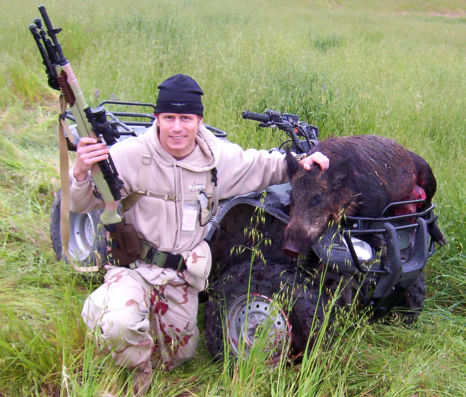
In all that high grass, I finally found the pig. It was a young sow
that had not suckled this year. It was nice and fat at about 110-120
lbs. I had not missed that first shot after all, but had hit the sow in
the udder. I hadn’t been leading far enough but was glad that the first
shot had not been higher. Fortunately, there was no damage to the belly
other than to the udder itself. You can see as much from the photo. The
meat is sweet and very tasty. I told the Missus that this was the very
best in free range, organic pork. She is warming up to the idea of my
hunting so long as the pork chops, ribs and sausage are all like this.
I think I may have set the bar pretty high. I now have an annual
boar-hunting trip planned with some close friends who have also been
inspired by your site and my own tale of modest success. I might even
get my father out there with me next year too.
Thanks, Mike
Hi Mike. First, thank you for your service to our great country. Congratulations on a fine hunt and good shooting. Good Hunting... from Varmint Al
My pig hunt with Varmint Al
by Dale Webb
After talking via E-mail several times I was invited to go pig hunting with Varmint Al at his cabin. We finally met on Dec 22 and I followed him up to the cabin. Right from the start it was a good trip, there were plenty of fresh pig diggings on the road to his place. We also spotted a bobcat having a mid-day snack on the remains a pig. Upon arrival at the cabin we were joined by Al's friend Dick and we all got introduced. We would have been content to sit on the back porch watching cows and trading stories if it weren't for the wind. With the cold wind blowing on an otherwise beautiful day we figured the best way to get out of the wind was to go hunting.
I took off down a canyon to the north with the intent of getting up someplace on the opposite ridge where I could have a good lookout over some thicker cover. From the creek I watched some deer for a while making sure not to spook them. One of the deer seemed very alert and nervous so I was hoping there was a coyote close by. Once I got past the deer, without them noticing me, I continued down the creek to the next ridge and started uphill. I had planed to get up behind the deer. About halfway there I glanced across the gulch and noticed what looked like a light brown rock. Something made me take another look with the binoculars. It was an animal of some sort lying down next to a tree about 100 yards away, but I couldn't tell if it was a cow, or calf, or pig. After I got within 50 yards I could see that it was a large pig. I didn't expect to see a pig bedded down in the open in the middle of the day. Having seen one dead pig already that day, I found a good place to sit down and watched to make sure this wasn't another. After a few minutes an ear flicked and it scratched its neck. That's all I needed to know! A quick shot through the top of the head and the easy part was done.
I was using my 30-06 rifle which had served me quite well on the 3 pigs I had taken while I lived in Hawaii, it now had a California pig to its credit also. I almost wish I had brought my 17 Remington Contender along, I'm sure a little 25 gr pill would have done equally well from the angle I had. It would have been neat to talk about how much gun it really takes to take a pig. The next biggest boar I've seen taken was with a 30 carbine. Oh Well, there have been several other times when I had the Contender and needed a rifle.
Anyway, back to the pig, it turned out to be a good size light brown color boar with tusks sticking out about 1 ¼ inch. Based on weights of pigs measured in Hawaii I guessed it to be about 150 to 175 pounds dressed, probably 200 or so live. After gutting it, I started dragging it downhill. It got bigger and bigger all the time. By the time I got down to the creek I was beat and the pig had to weigh at least as much as my Jeep. Realizing I wasn't going to get out before dark with the pig, I left it and went to get Al, also checking to see how close I could drive.
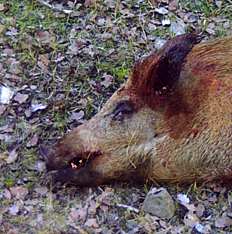 No beauty contest winner here.
No beauty contest winner here.
When I arrived at the cabin, cold, tired and bloody, Al and Dick were sitting inside nice and warm by the stove. Not turning around when I came in, Al jokingly asked if I needed help getting my pig back. When I said yea, he turned around and saw my dirty hands, the look on his face was worth the trip in itself. Then he proceeded to remind me that a successful hunting trip doesn't mean you always have to get something, and that his trip was going great until I made work for everyone. Dick was pleased that after all the times he had been to Al's cabin, someone had finally gotten a pig while he was along.
The closest we could drive was about a mile from where I had left the pig, so after a short attempt at dragging him across the rocks in the creek bed we decided to cut him up right there and take out the pieces. Unfortunately I hadn't brought my camera in at that time. After taking off the quarters we hung the remainder in a tree for the night, since it was around freezing, spoilage wasn't a problem, but we wanted to keep the coyotes off the remaining good meat. The next morning I went back with my Contender and camera. I called for coyotes near the gut pile without any response. I cut out the tenderloins from what was left of the pig and took a few pictures of the head showing the tusks. Back at the cabin I boned out all of the meat and stuck it in the ice chest for the trip home.
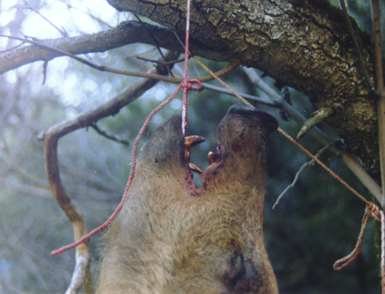 Tusks to better chew you with.
Tusks to better chew you with.
Based on the first taste less than a week later the meat is fine, even being from a good size boar. Perhaps an instant kill while at rest had something to do with it.
After all these years of unsuccessful hunting, I am finally starting to collect. I still haven't taken a deer, but I have got four pigs now. My wife used to let me go hunting because I never brought anything home and now she is starting to have second thoughts. I had better start being more careful, maybe even take Al's advice and sit around the wood stove a little more.
THE BOAR
By Zechariah Flaugh 2-16-01
It all started in July of the year 1999. At a little, call your own shots shooting range in
Los Alamos, New Mexico. Me (Zech) and my good buddy Trent where testing our hand loads and just having fun
shooting. We met a guy we will probably never see again, but he told us about the pigs. He said the name of
some no name town where you could walk down a trail and get charged by killer wild pigs. Well, as a hunter, an
adrenaline junky, and teenager that sounded pretty cool to me, but we went home and pretty much forgot about
it. Until six months later when Trent heard someone else say something about pig hunting in the same no name
town. Now we had to check this out. I emailed about 50 people that either lived there, had lived there, or
vacationed there. I got back 4 emails. They had a couple of phone numbers, one of which was the Game and Fish
department. I called them up and found out that it was true, but that they didn't know where I could go. So we
thought back to where the guy at the shooting range said to go and we started planning.
We got a guy with a Blazer (George) that wanted to go and so we had transportation. He played football and had
2-a-day practices so we left at nine o'clock on Friday night for a weekend hunt 700 miles away. We had a vague
idea of where to go and no idea how to hunt pigs, but that didn't even slow us down. We drove all night,
listening to a Stephen King book on tape about a mysterious gunslinger in a different time and place, we found
a camping spot at 4:00 am Saturday Morning. We set up camp and passed out in the tent.
I have always been an early riser, I got up at 9 o'clock, loaded up my .22 mag and headed out to do a little
recon. We had no idea where we were. I started climbing the ridge behind our camp, very slowly, very quietly.
I started seeing pig sign immediately. Thirty minutes later I was at the top of the ridge looking out across
some very beautiful, very rugged country. The mountain the guy at the shooting range had mentioned loomed in
the distance, I recognized it from a picture I found on the internet. The country was STEEP. Up and Down. Up
and Down. Oak brush and stinging nettles so thick you could barely walk through them. I thought I heard some
snorting up there by myself, but I didn't know because I had never seen or heard a pig in the wild before . I
headed back to camp and woke my comrades.
I switched to my 22-250, George loaded up his 7mm mag and his .357 revolver, and Trent loaded up his .243. The
sound of bullets sliding into chambers was loud in the stillness of the morning. We walked down the road and
found a trail that got us back into the rough country by the mountain that the man at the range had mentioned.
We split up and started working uphill. One walked up the creek bed and the other two took the sides. Two
hours off almost impenetrable oak and hellish stinging nettles we came out on top. All the way up I was
convinced that there was something close but I never saw it. When we came together on top though George said
he had seen a little piglet but never had a clear shot. Moral soared! We decided to walk together up the
ridgeline to a highpoint where we could see the lay of the land. We walk along, talking, excited, there where
pigs out there somewhere. Now we knew. It wasn't a rumor. It was a FACT.
The pig got up so fast and so loud that all us jumped. That was the end of the surprise for us and the
beginning of the end for that big old boar. It ran into a little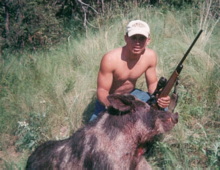 clearing at top speed and George and Trent, firing at the same time, put two bullets right behind the
shoulder. This pig didn't want to die though. It kept going, I was afraid we where going to loose it in the
bush so as
clearing at top speed and George and Trent, firing at the same time, put two bullets right behind the
shoulder. This pig didn't want to die though. It kept going, I was afraid we where going to loose it in the
bush so as 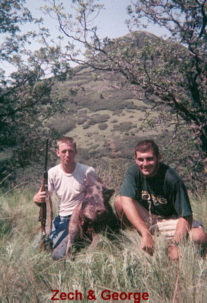 soon as those guys fired I
was running as fast as I could. My 6x-24x scope was a real problem at this 50 foot range and I aimed down the
barrel and put a bullet up that suckers butt. It's rear end folded, but it was going down hill now. I ran
around to get even with it in the stand of large oaks it ran into, almost stepping on a new born baby deer
that jumped up a foot away from me as I ran. I fell down the steep hill, rolling through the underbrush, but
somehow keeping my gun from hitting the ground. I got up and saw the pig, dragging it's rear end about 30
yards away. I leaned up against an oak, took aim on the back of it's head and started to squeeze off when
Trent shot it right behind the ear from the top of the oak grove. It spun around and slide down the hill,
coming to rest against a big old oak. Dead.
soon as those guys fired I
was running as fast as I could. My 6x-24x scope was a real problem at this 50 foot range and I aimed down the
barrel and put a bullet up that suckers butt. It's rear end folded, but it was going down hill now. I ran
around to get even with it in the stand of large oaks it ran into, almost stepping on a new born baby deer
that jumped up a foot away from me as I ran. I fell down the steep hill, rolling through the underbrush, but
somehow keeping my gun from hitting the ground. I got up and saw the pig, dragging it's rear end about 30
yards away. I leaned up against an oak, took aim on the back of it's head and started to squeeze off when
Trent shot it right behind the ear from the top of the oak grove. It spun around and slide down the hill,
coming to rest against a big old oak. Dead.
The work began then. We gutted it, drug it into the shade, and went back to camp for the packs and the saw. We
quartered that big 300 lb. Boar up. Loaded onto pack frames and hiked it the three miles back to camp. We
spent the rest of that trip sleeping in and taking long afternoon hunts, but we never saw another pig. But we
did see a lot of beautiful country, spent hours on the top of high ridges looking out over hundreds of miles
of terrain and watching huge herds of elk feed and play in the meadows far below. That hunt will be hard to
beat. I know I will never forget how we took a stab in the dark claimed a little beginners luck, and bagged a
trophy boar. Email to Zechariah Flaugh
MY FIRST & LAST WILD BOAR by Varmint Al.... My first wild boar was taken in the late fall of 1987 up at my mountain cabin. It was early morning before sunrise and I was watching a trail with a lot of pig tracks on it. I saw the black boar at about 200 yards and setup on my Bi-Fur-Pod and hit him in the shoulder with a 243 100 gr. Sierra Spitzer out of my Sako (with the original factory barrel). The boar dropped like a rock and I could see his feet kicking through the binoculars. I got over to him in about 5 minutes and poked him with the rifle barrel. He seemed dead to me. I bled him out and field dressed him. He was about 250 pounds and there was no way I could haul him up the hill without help. I drove over to the nearest neighbor and with my truck, and a cable, we pulled the boar up the hill to the road. I got him to my cabin and hung him up in a tree for skinning. The scary part was that when I found the bullet, it had stopped in the inch and a half thick shoulder hide! The bullet had not penetrated to the body cavity! When I walked up to the boar and started field dressing him, he could have gotten up at any moment and with his 4 inch long exposed tusks, could really have done a job on me. I will never take another large boar. It was the toughest, strongest tasting, foulest smelling meat I have ever had to eat and the bad part of it was that there was so much of it. Mary Ann said that I could not get the boar's head mounted and hang that nasty looking thing in our living room. I still use the 243 Sako to hunt wild pigs, but no more large ones. Wild pigs at between 50 to 75 pounds are very tender and good tasting. I like them better than even venison.
WILD BOAR HUNTING STORY
by Kevin
My brother and I spent Easter'98 hunting Russian Boar in Vermont. We each bagged a boar. Mike, my brother,
got his Friday. His 1st 5 shots from his Dan Wesson 44 Magnum really seemed to annoy that boar. He then
switched to a 44 Magnum carbine and using dogs tracked the pig 1/2 mile or so and finished him with another
volley of fire. I was hunting one valley West of Mike and it sounded like Custer's last stand. As another
hunter commented " That pig weighed 175 on the hoof, and 200 when Mike finished firing! Total shots fired
11- total hits 10.
I was hunting with a Colt Anaconda 6" equipped with a Holosight. I was staked out on the juncture of
several game trails. Down this winding -downhill trail comes this good-sized boar, head on. When he spots us
he starts snapping and popping his tusks and finally gives me an angle on his left shoulder. Fired once, a hit
and he angles left, exposing his right shoulder- fired again, another hit and he turns to head back uphill.
Third shot, all at 15- 20 yards, directly into his hind quarter really seemed to motivate him to setting an
uphill speed record. We tracked him into a hilltop thicket and three additional 44 Magnums convinced him to
lie down, with a final round to put him down from 10 feet. Total 7 rounds - 7 hits and 225 lbs of boar. The
meat was actually pretty good, especially the hams and sausage. I'll do it again, but maybe with a Encore in
30-06.
 JEFF AND THE TROPHY BOAR.... In the
Livermore gun shop, there was a wild boar head mounted on the wall with about 5 inches of exposed tusks. At
the time, I had just purchased my mountain cabin. There was wild pig sign all around the cabin and I was
interested in wild pig hunting. Well, I asked the fellow in the gun shop about the wild boar trophy on the
wall. Jeff 's (I think that was his name) eyes got big and he started to shake a little and here is his story
as best I can remember it.
JEFF AND THE TROPHY BOAR.... In the
Livermore gun shop, there was a wild boar head mounted on the wall with about 5 inches of exposed tusks. At
the time, I had just purchased my mountain cabin. There was wild pig sign all around the cabin and I was
interested in wild pig hunting. Well, I asked the fellow in the gun shop about the wild boar trophy on the
wall. Jeff 's (I think that was his name) eyes got big and he started to shake a little and here is his story
as best I can remember it.
Jeff and his hunting partner were out hunting wild pigs. Jeff was half a mile from his partner and he saw some big pig tracks heading into a thicket of manzanita and juniper brush. He followed the tracks into the thicket (bad move) and when he was in about 50 feet, he hears the brush start to break up and what sounds like a freight train starts breaking brush his way and fast! Well, Jeff turns around and starts running out of the brush. About half way out, he drops his 30-60 rifle. It wasn't clear if he dropped it by accident or if he dropped it so he could run faster.
Jeff makes it to the edge of the brush and now he sees that the freight train is a big black wild boar running after him and snapping and popping his tusks. Jeff runs 40 feet more to a small oak tree and starts climbing. He gets up a short way in the tree and a branch breaks off. The branch jabs a hole in his right forearm and he is hooked there. The boar comes over to the tree and starts butting the base of the tree with his head and shoulders. Jeff's feet are about 2 inches above the back of the boar, but the boar doesn't look up. Well, Jeff reaches around to get his Ruger Super Blackhawk 44 Magnum with his left hand. He aims at the center of the withers and fires one off. The boar drops. But, Jeff is not used to shooting with his left hand and the 44 Magnum rocks back in his hand. The hammer tang punches a hole in the web of his hand between his thumb and fore finger. He drops the 44 Magnum on the boar. Well, Jeff is semi lucky. At least the boar is dead. Jeff gets his forearm unhooked from the broken branch and jumps down on the boar and falls to the ground a bloody mess. There is blood dripping from both hands.
When Jeff and his hunting partner get back to their truck, they tell the farmer what happened. Jeff didn't want to see that boar again, but the farmer gets his tractor and drags the 300 pound boar out and helps them load it into the truck. It is no wonder that Jeff says that he doesn't hunt wild pigs anymore. When we walked out of the gun shop, we looked up at the wild boar trophy with a bit more respect.
Last Updated: 07/19/2015
End of Page![]()